President Trump signed an executive order on Wednesday pushing ahead one of his signature campaign stumps—the construction of a massive $14-20 billion wall along the 2,000-mile-long border with Mexico, designed to deter illegal immigrants and drugs from entering the United States.
The wall has faced fierce criticisms from human rights groups for the possible humanitarian disaster it could cause (ask Berlin about this). But if built, the wall could pose another threat altogether: ecological disaster.
A barrier would sever animal populations living in the fragile desert ecosystems of the US-Mexico border from food resources, mates, and important migration routes. Such a disruption would deal an irreparable blow to countless species, including extraordinarily rare ones like the Sonoran jaguar and Mexican gray wolf.
According to a US Fish and Wildlife Service provisional report released last year, a Trump wall covering the entire 2,000-mile border, with approximately 1,000 feet of developed space on either side,would potentially impact 111 endangered species, 108 species of migratory birds, four wildlife refuges and fish hatcheries, and an unknown number of protected wetlands.
Read more on Motherboard
Trump’s Mexican Border Wall Would Be an Ecological Disaster
Trump's Trouble with Numbers Is America's Problem Now
Back when Donald Trump was just a guy who put his name on skyscrapers, casinos, and steaks, no one needed to worry too much about his habitual exaggerations. Braggadocio comes with the territory for being famous and getting richer by playing a rich guy on TV—the public didn't want Trump to be humble any more than they wanted Paris Hilton to be bashful. He was persistently on-brand before being on-brand was really a thing. That meant, for instance, badgering Forbes in an effort to get the magazine to revise its estimates of his net worth upward. (Forbes said Trump was worth $3.7 billion at last count.) It meant being "obsessed" with the ratings of The Apprentice, according to a former NBC PR man. It meant showing up at a struggling school in the Bronx and handing out a fake million-dollar bill.
In the course of this on-brandness, Trump could, well, exaggerate sometimes. When journalist Tim O'Brien challenged him on his net worth, it led to a lawsuit during which Trump was forced to admit that his sense of his worth was based on his own feelings. When The Apprentice's ratings dipped, Trump told that PR man to keep telling reporters it was a number-one show. And he actually only gave that Bronx school $200.
None of these things really hurt anyone (well, the parents at the school were disappointed). Trump might have been a billionaire, or so he insists, but he wasn't a particularly powerful one. He was on the fringe of American life, a sideshow, a hype man, the type of dude who gets roasted on Comedy Central—where, incidentally, he demanded that no one make fun of him for having less money than he said he did.
This fuzzy math, however, is going to matter a lot more now that Trump is the most powerful man in the country—and the consequences could be more far-reaching and severe than many people think.
The federal government does a lot of things, but a major function involves tracking the basic facts of American life: how many people live in a certain place, how many of those people are out of work, how much money a bridge will cost to build, how much the IRS collects in taxes, how many pollutants are floating in our air or swimming in our water. Public officials use those numbers to make policy, journalists use them to report on various problems facing the country, average citizens can look them up if they're curious about something. Sometimes there are debates about the relative importance of certain numbers, but a great deal depends on people more or less agreeing about basic facts.
When a basic fact challenges Trump, he tends to reject it. He did some routine number-stretching during the campaign, regularly exaggerating the sizes of the large crowds he attracted to emphasize how hugely, big-league popular he was. And this habit has continued after his win: On Monday, he sent his press secretary Sean Spicer out to tell the media that more people had attended his inauguration than Barack Obama's. This sparked more debate about crowd size and invited coverage that was unflattering to Trump, but it also indicated just how insistent this administration is going to be when it comes to defending the president's assertions.
The size of a crowd is not really going to affect public policy either way. What matters more is Trump's subsequent insistence that millions of people voted illegally. On Tuesday, Spicer told the White House press corps that the president "believed" this to be true, but didn't offer any evidence. When reporters pointed out that if this were true it would be a huge scandal that should be investigated, Spicer demurred and didn't say if there were plans to investigate. Everyone, including mainstream outlets like CNN, pointed out how truly ridiculous all this sounded—but on Wednesday morning, Trump showed how far he was willing to go, calling for an investigation (via tweet) into this supposed voter fraud.
These accusations closely follow right-wing claims that it's easy for fraudsters to vote multiple times because millions of people are registered to vote in more than one state. But it's not illegal to merely be registered to vote in two different places (as White House adviser Steve Bannon reportedly is), and the fear is that crackdowns on voter fraud will just make it harder for poor people, particularly minorities, to vote, giving Republicans an electoral advantage. The millions of phony votes may just be a "belief" of Trump's, but that belief may have real-world consequences.
This is just the tip of the iceberg. Trump has indicated that he thinks the unemployment rate might be "42 percent," which is based on a faulty understanding of how unemployment is measured. When Spicer was asked on Monday what the unemployment rate is, he didn't even say, instead talking about how the Bureau of Labor Statistics (BLS) puts out "several versions" of that number. But the unemployment rate is a very specific statistic that measures the percentage of people who are actively looking for work but haven't found it, and according the the BLS, it's currently 4.7 percent. It's right there on the federal agency's website. (Since his election, Trump has also exaggerated the number of undocumented immigrants with criminal records.)
So, will Trump and his administration ignore his own government? Will certain true information that has been put out by the federal government be taken offline, a la the White House's order that the EPA remove its climate change page? Will federal employees be put in the awkward position of having to contradict their boss when he exaggerates or else follow along in his untruth? (Spicer in particular is already in a pretty miserable position; he wouldn't say when asked if he agreed with Trump about the alleged voter fraud.)
The numbers that the federal government tracks aren't fungible like the value of Trump-owned properties. They monitor realities—they are how we judge a policy's success or failure, the basis for conversations about the direction America should take. The danger isn't that the president keeps exaggerating, it's that people start thinking the government's numbers are just as suspect as Trump's.
Follow Harry Cheadle on Twitter.
A Burger King Was Allegedly Selling Weed to Customers Who Asked for 'Extra Crispy Fries'
A couple of fast-food employees in New Hampshire are now facing charges after they were busted for selling weed out of the drive-thru of their local Burger King, Seacoast Online reports.
The two masterminds, Garrett "Nasty Boy" Norris, 20, and his alleged accomplice Meagan Dearborn, 19, were apparently selling marijuana to customers who came to the establishment and specifically asked for "extra crispy fries."
It's not clear how long the pair was running their side hustle before police in the town of Epping—population 6,144—caught on. Last Saturday, an undercover cop pulled up to the restaurant, asked if "Nasty Boy" was working, and then placed his order with a side of extra crispy fries. Norris then reportedly gave the guy his Whopperito or whatever, along with a coffee cup full of pot.
Norris was charged with possession of an unlawful substance and intent to distribute. Dearborn, an assistant shift manager, was also arrested and charged with conspiracy to distribute and unlawful possession of alcohol. They were both released on $2,500 bail and will be arraigned next month.
Unfortunately, for Nasty Boy Norris and Dearborn, New Hampshire's state legislature voted down a bill to legalize recreational marijuana, so they may want to think about taking their business model to one of the many states that has legal weed. In fact, Oregon already has its own drive-thru for smokeable green stuff. Sadly, though, you'll have to make an extra stop for an Oreo Cookie Cheesecake.
Why One Man Let Mosquitoes Bite Him 200 Times
This article originally appeared on Tonic.
For 10 minutes, the mosquito colony feasted on Rafael Hernandez's arm. If Hernandez needed motivation to hang in there, he could remind himself that volunteering his body as a parasite buffet was for an undeniably good cause. Hernandez, a Seattle-based pediatrician, was one of just 10 people who participated in a recent study conducted by the Center for Infectious Disease Research in Seattle to help develop a vaccine for malaria, which poses a risk to at least half of the world's population. In 2015, 214 million people contracted malaria and 438,000 died from it, according to the World Health Organization.
Malaria is spread when a female mosquito—specifically an Anophele mosquito—becomes infected with a genus of parasite known as plasmodium, says Ashley Vaughan, a scientist at the Center for Infectious Disease Research and an author of the study. When the infected mosquito bites a human, the parasite enters the bloodstream and travels to the liver, where it forms a cell called a hepatocyte. After about a week of incubating, the hepatocyte bursts, spreading malaria throughout the body.
Much to the relief of the researchers, Hernandez was doing just fine a week after the feeding frenzy. The mosquitos dining on his forearm had been genetically engineered to carry a weaker strain of malaria missing three crucial genes—p52, p36, and sap1—thereby preventing the virus from entering and incubating inside the liver, Vaughan says.
Researchers created the modified parasites using transfection technology; they essentially removed those three genes and their genetic material coding from the genome. This means the genes are permanently eliminated and the parasite can't mutate and replace the genes, says Vaughan.
"The study shows that genetically attenuated parasites are completely safe. Immunization with the parasites does not lead to blood stage disease," Vaughan says. "Because of the deleted genes, the parasite dies, the antigens develop, and you get an immune response."
While none of the participants developed blood-stage disease, they'd likely need several "doses"—much like the Hepatitis C vaccine, for example—before they'd become completely immune to it. But blood tests indicated that participants did develop antibodies to malaria, meaning their immune systems' might be able to recognize and fight off the disease.
Unfortunately, a vaccine for the rest of us is still probably years away, the researchers say. One reason is that the only way to develop immunity is exactly the way Hernandez did it. (It will take more time to develop a traditional, needle-based vaccine.) The researchers also still need to prove that it's effective in larger groups of people so they're starting a bigger trial in June. Then they have to test it in people in malaria-prone areas who generally are harder to protect than people in malaria-free regions.
Until then, we'll bring you the next closest thing: Here's what it feels like to be dinner for a swarm in the name of science.
Tonic: Okay, let's start with the obvious: Why on earth would you agree to this?
Rafael Hernandez: Vaccines have been one of the great public health interventions of the last 100 years. We still don't have an effective vaccine for malaria, and after hearing about the successful trials of this vaccine strategy in animals, I thought it offered the potential to save hundreds of thousands of children a year. As a pediatrician, I also think it's my responsibility to help care for children in my community.
But weren't you scared of the potential consequences? We're talking about a deadly disease.
Not really. I knew that the vaccine was based on a strain of malaria that was very easily treated. I also am not bothered by blood draws, so the daily blood tests were not a concern. Getting bitten doesn't bother me much, either. After a day, I almost always have a strong reaction. This time, I was a little anxious about the reaction I was going to have. Because my bites get very swollen and itchy, I feared that hundreds would be even worse. So, having said that, it was weird to then intentionally set my arm over a container full of buzzing mosquitoes.
What did it look like?
The mosquitoes were essentially inside of what looked like a Chinese take-out container with a screen drawn across the top. We were asked to lay our arm across the screen and then cover our arm with a towel to keep the mosquitoes out of our sight. At first, the bites felt like more of a tickle. Then it transitioned into more of a stinging sensation, but it was not severe.
Didn't it itch like hell afterwards?
I do tend to get a little itchy, so I was anxious about that, too, but knew the effects would be temporary. I used a topical hydrocortisone cream, which provided some relief, but since I do have a strong reaction, they still itched quite a bit. Any distraction was very useful.
How bad was your arm?
It was red and slightly swollen in the shape of the container, but the itching went away after about 10 days. I would absolutely do it again. The development of a vaccine is very important.
Action Bronson Thinks Tokyo Is Like 'Final Fantasy VII'
On an all new episode of Fuck, That's Delicious, the gang heads to Tokyo, the next-level New York, where Action Bronson, along with the Alchemist and Meyhem Lauren, take on a variety of cuisines, rap, and sumo wrestling.
Fuck, That's Delicious airs Thursdays at 10 PM on VICELAND
Want to know if you get VICELAND? Head here to find out how to tune in.
I Asked My Tinder Matches About the Most Rebellious Thing They've Ever Done
Several Labour frontbenchers are understood to be considering a rebellion against Jeremy Corbyn's plan to whip MPs into voting to trigger article 50, so I asked my Tinder matches about the most rebellious thing they've ever done.
MATCH ONE
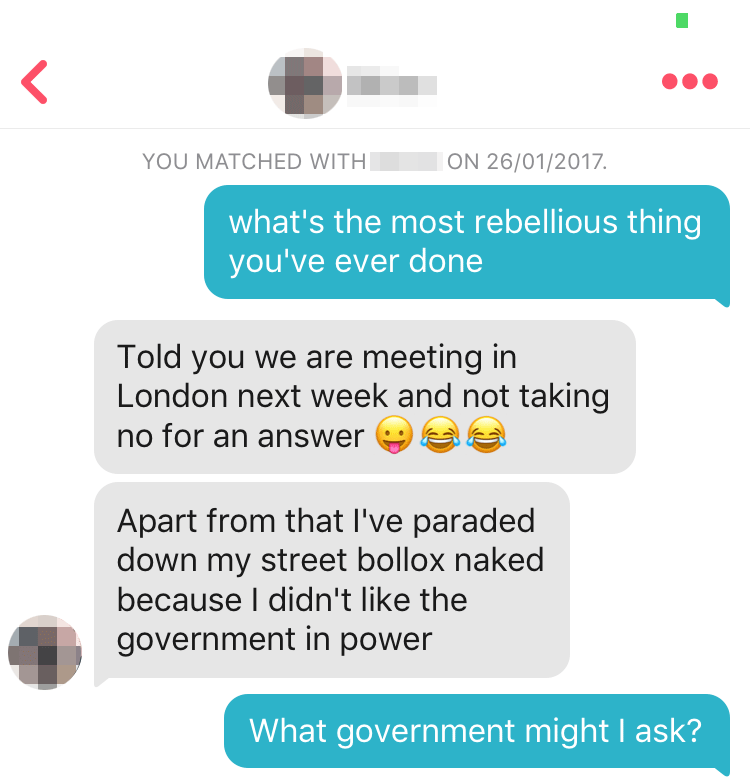
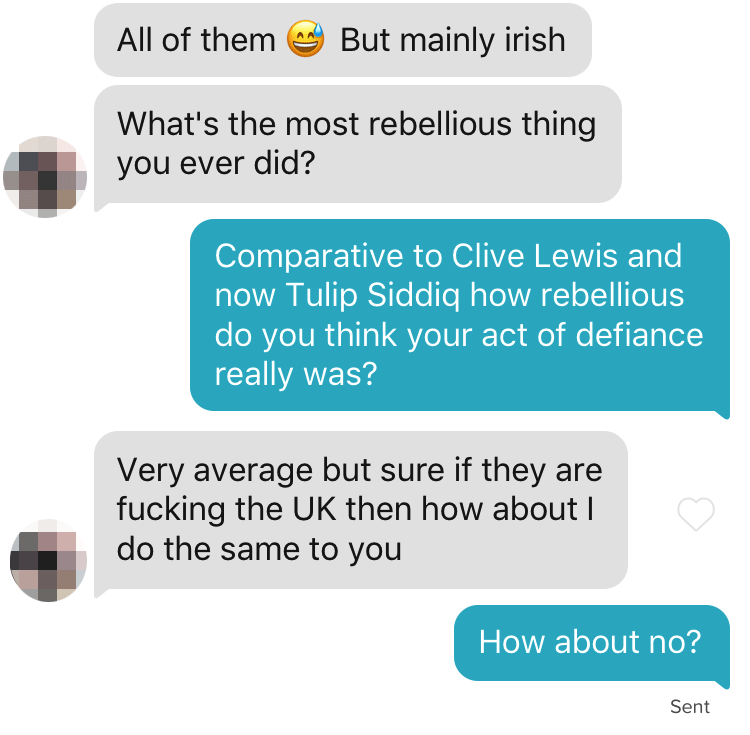
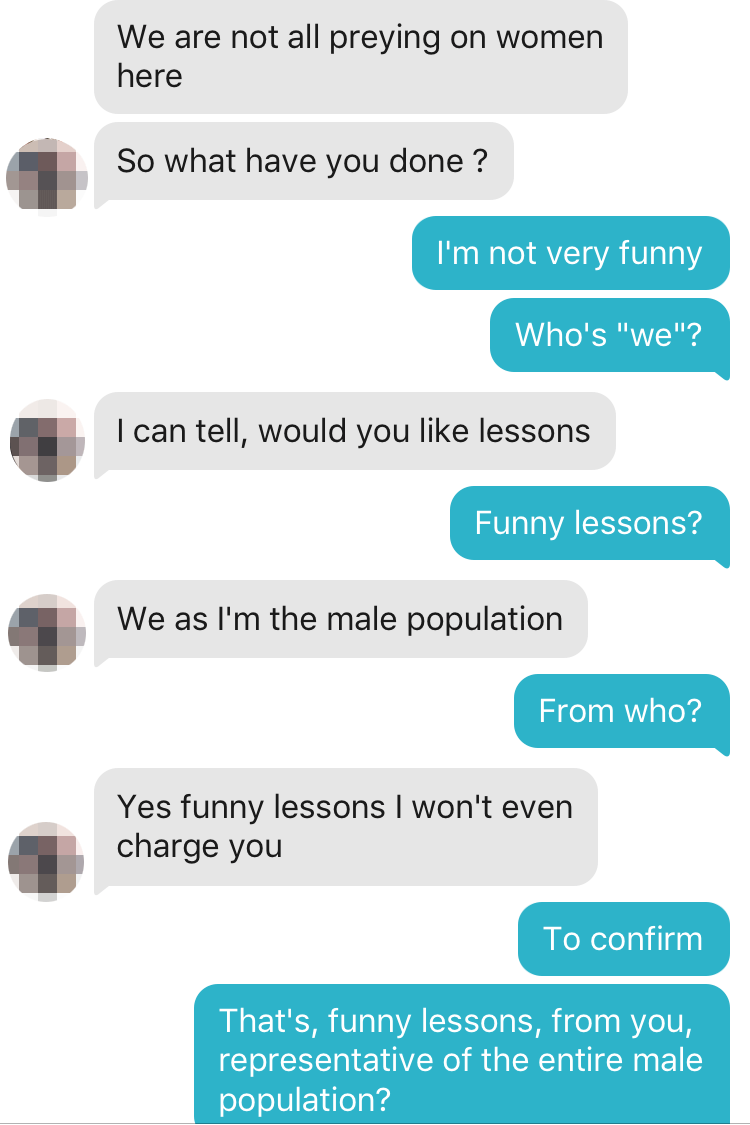

MATCH TWO
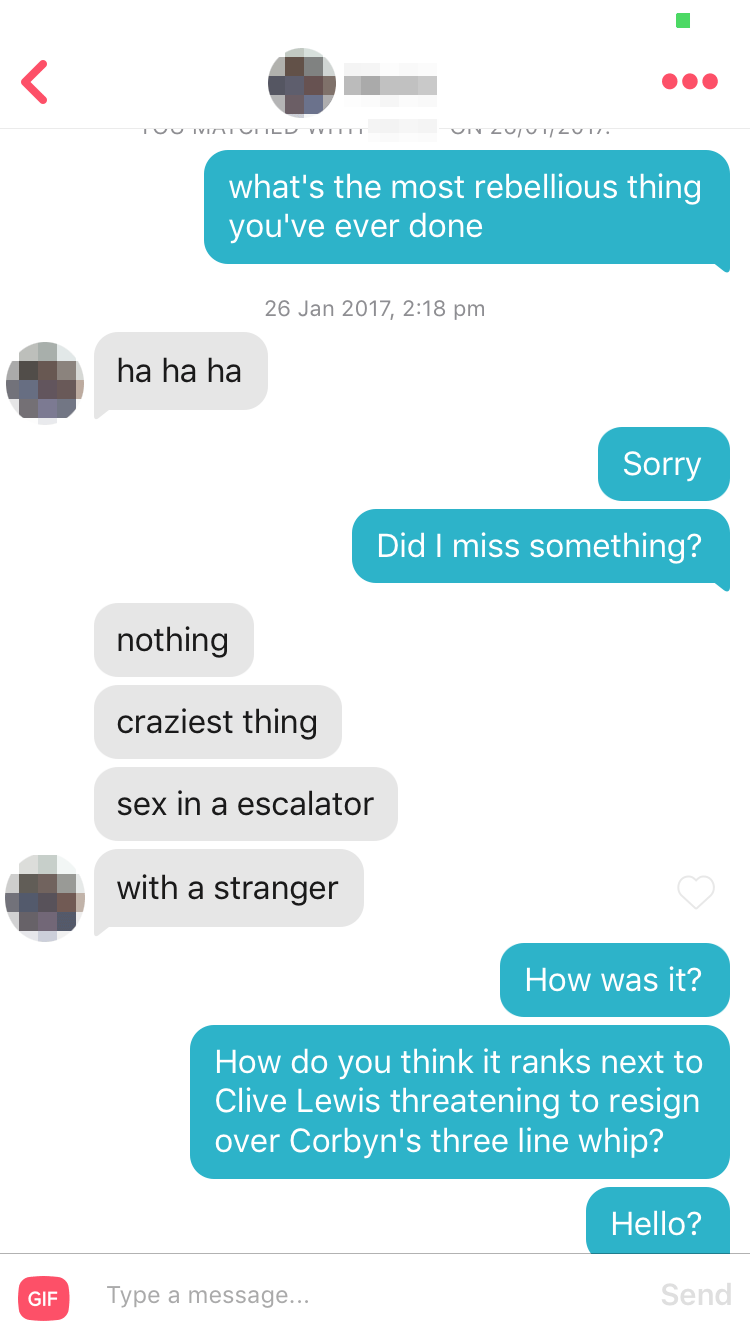
MATCH THREE
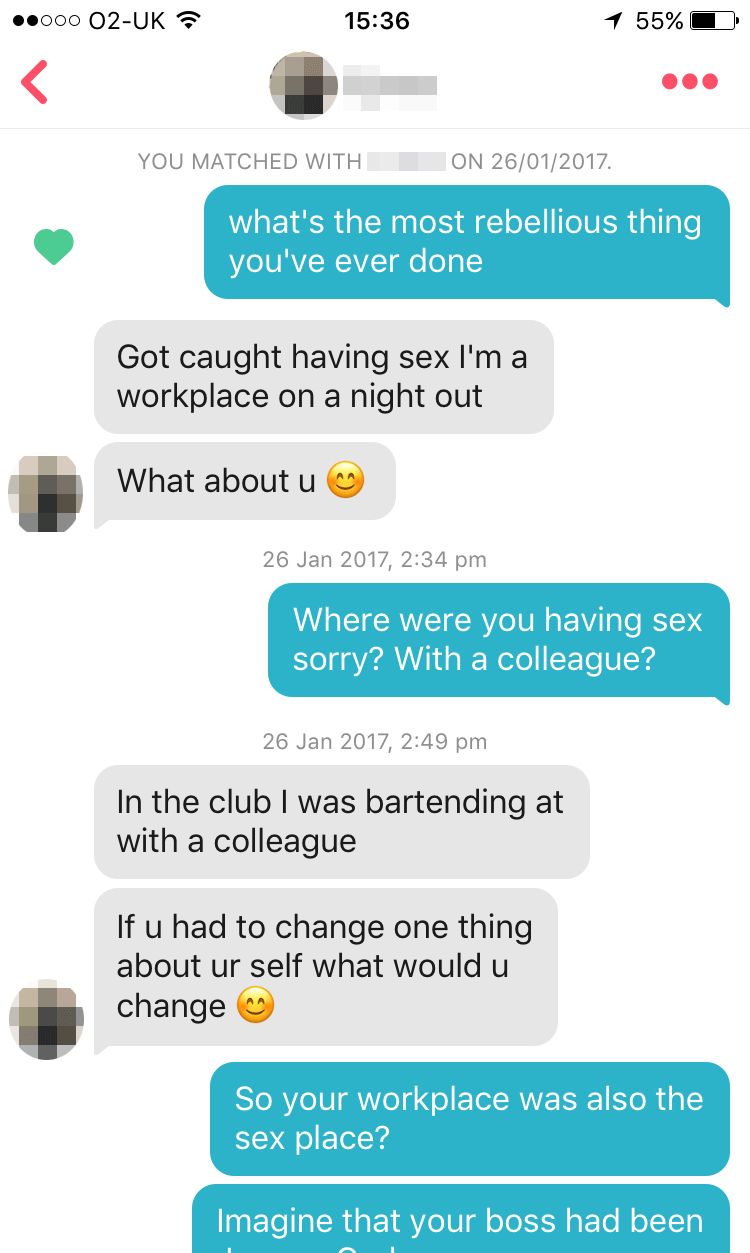

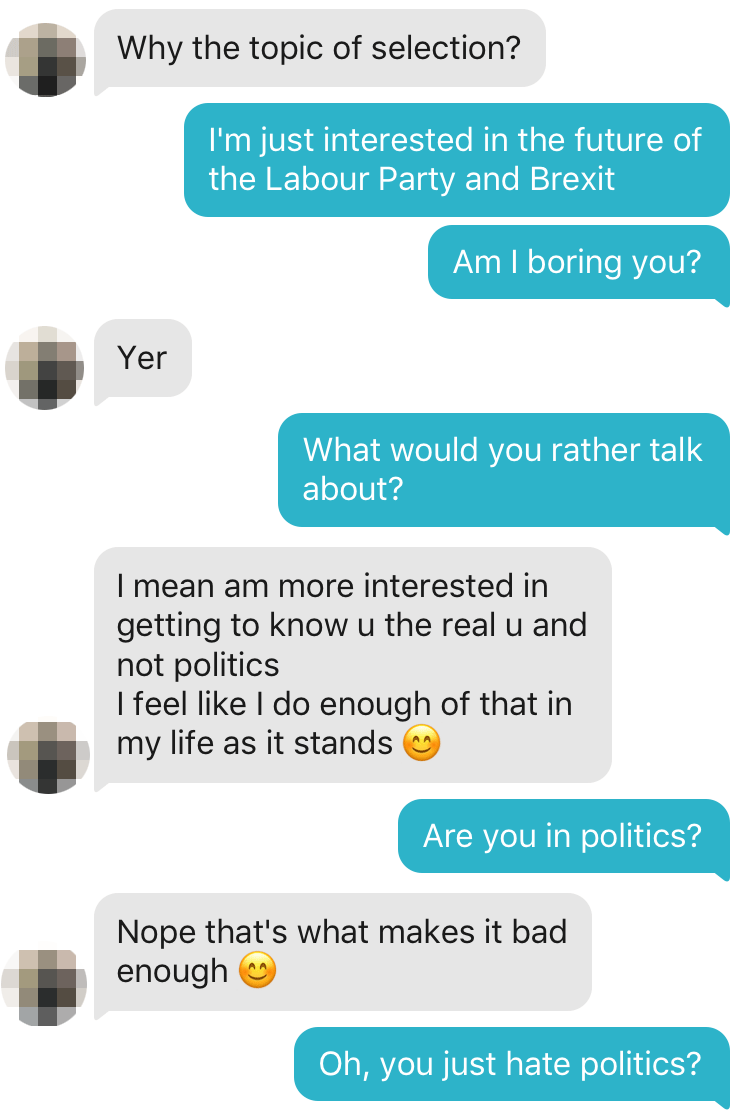
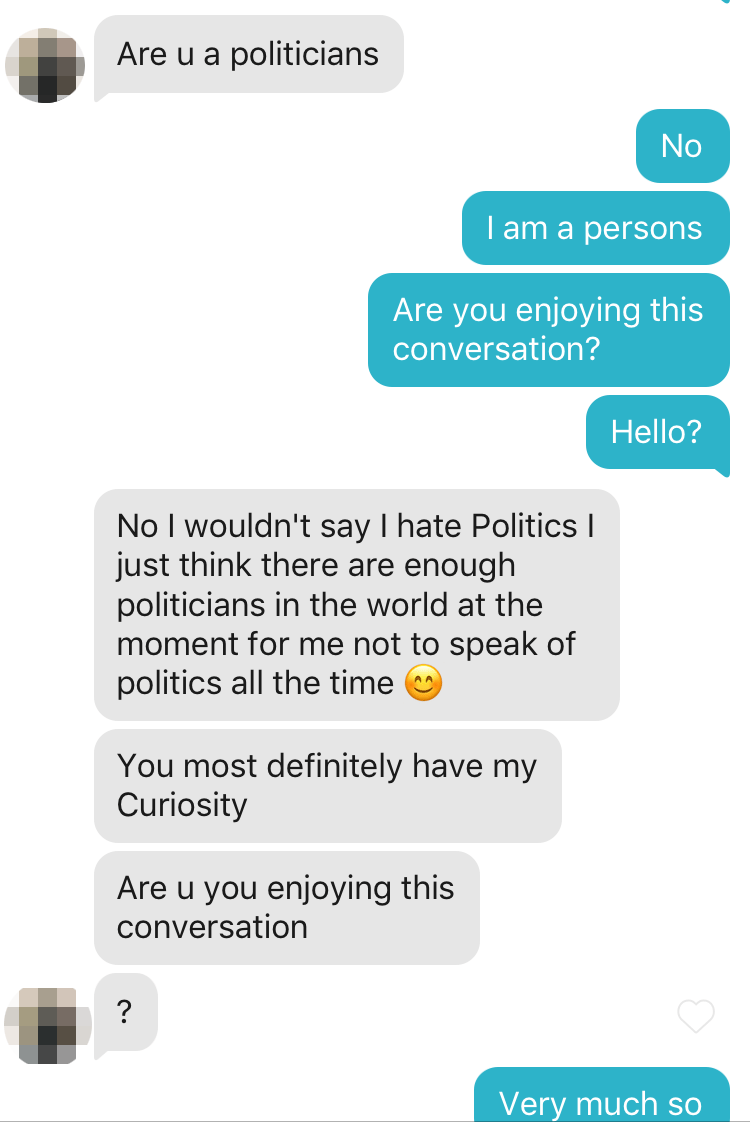
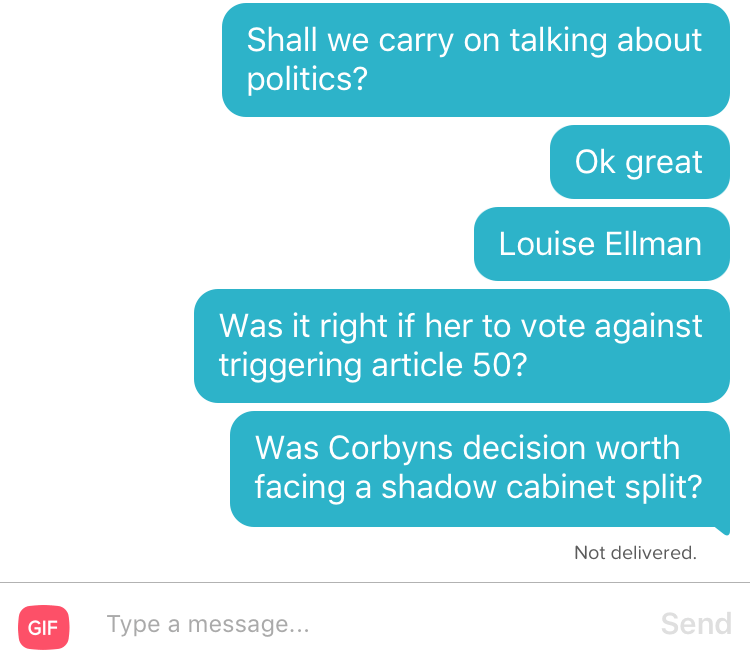
La Mano Negra y su 'Patchanka Style'
Manu Chao recién lanzó tres nuevas canciones. Desde La radiolina (2007) no había publicado algo inédito. Para sus seguidores fue más que una sorpresa: fue una esperanza de que tal vez este año tengamos nuevo material del ex líder de Mano Negra. Sin embargo, es inevitable pensar en Manu y soñar con un reencuentro de los verdaderos creadores del patchanka style.
La Mano Negra, siempre lo he pensado, es una excelente banda de iniciación. Lo digo así porque los escuché cuando tenía alrededor de 8 años, a mediados de los noventa, gracias a In the hell of Patchinko (1992), su disco en vivo que grabaron en Kawasaki, Japón. En él descubrías diferentes ritmos musicales que mezclaban en sus canciones. Su historia todavía no me interesaba. Lo único que disfrutaba eran sus gritos, sus coros pegajosos y esa energía que se desprendía de las bocinas, la cual me hacía sentirme el Rey de la Selva mientras saltaba en la cama de mi tío Roy, el responsable de que me volviera loco al escuchar esa música, aun cuando ni siquiera sabía cómo eran, cuántos integraban la agrupación y de qué país provenían.
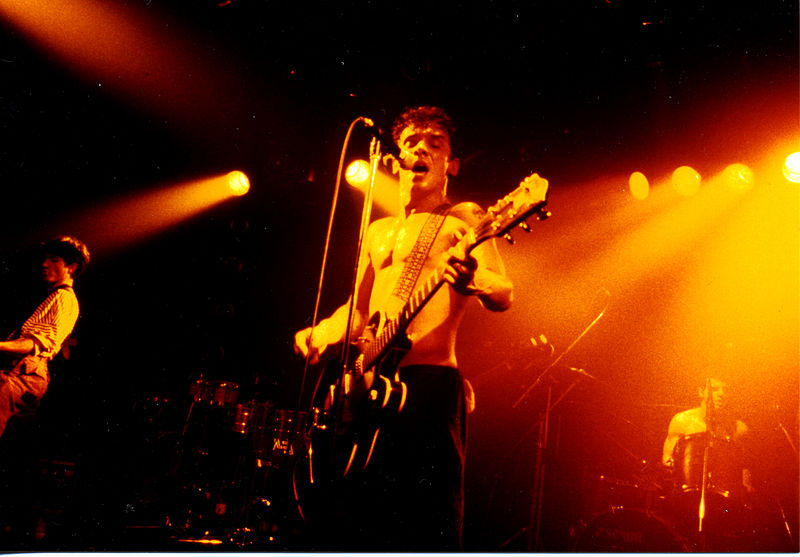
Los años transcurrieron y la mejor escuela que pudo existir se llamó Mano Negra, cuando dabas de frente con toda esa serie de influencias que tenían, cosas nuevas que descubrías y que siempre terminaban recordándote a ellos, quienes solían ser conocidos como los nuevos The Clash. Hay quienes se atreven a decir que fueron mejores que ese heroico cuarteto británico de punk liderado por Joe Strummer. Sus frenéticas presentaciones en vivo los volvían únicos, apasionados y con un talento que muchos aseguran no se había visto antes, en ninguna parte del mundo, y que estoy seguro difícilmente se repetirá. Tanto así que inventaron su propio estilo que definieron como patchanka y sus fanáticos saben que "se conocieron en el Metro de París y se separaron a bordo de un tren colombiano", que es algo mágico y especial.
¡Mano Negra, moreno!
La primera gran sorpresa que me llevé es que fue en París, Francia, donde comenzaron a ensayar en forma. Pero su historia inicia en Sévres, suburbio de la capital francesa ubicado al suroeste. Ahí Manu Chao, su hermano Antoine Chao "Tonio Del Bornio" y el primo de ambos, Santi Casariego formaron Joint de Culasse, su primera agrupación de rock & roll. Los tres editaron un álbum de covers en el cual interpretaban "Louie Louie" de The Kingsmen, "Memphis Tennessee" de Chuck Berry o "Blue suede shoes" de Carl Perkins. Esto sucedió a principios de los ochenta, cuando tenían alrededor de 20 años y ese sonido se convertía en su influencia principal.
Por esos mismos años Manu y Santi se unieron a Les Flappers, en un momento donde la escena de rock francesa comenzaba a crecer. Finalmente Joint de Culase se separó y nacieron los Hot Pants en 1984. Los primos-hermanos Chao-Casariego continuaban tocando juntos. Hot Pants podría considerarse la banda con la que Manu comenzó a tomar popularidad. Su sonido era abrumador: uno de esos momentos de inquietud donde comenzaron a mezclar ritmos latinos con el flamenco, experimentado con sus raíces y gustos propios. Cantaban en inglés y español, ganando gran reputación en el underground parisino e interpretando temas como "Mala vida" o "Junky beat", que se convertirían en rotundos éxitos de la Mano Negra. No obstante, su discografía se limitó a un Demo, un sencillo de 7" y su álbum Loco mosquito.
En esos tiempos la escena subterránea de París era un escape de salida tanto para la juventud como para los músicos que la conformaban. Era una época donde las bandas alternaban entre sí, organizando conciertos por diferentes bares y ocupas de la ciudad.
Para 1987, en el auge del rock francés, Hot Pants alternaban mucho con Los Carayos, donde también participaba Manu, reencontrándose –musicalmente hablando– con su hermano Tonio Del Bornio. Sin embargo, Manu al parecer seguía buscando ese sonido que lo caracteriza hasta el día de hoy. Así fue que junto a Santi en la batería, Tonio Del Bornio en la trompeta, Alain en el contrabajo y Mamack en el saxofón se hicieron llamar La Mano Negra, como los guerrilleros de América del Sur que Dominique Rousseau había plasmado en uno de sus cómics.
A finales de 1987 lanzaron un primer sencillo que incluía la canción "Takin' it up" con el famoso logotipo de la mano sobre la estrella roja y el fondo amarillo y negro; el mismo que serviría como estandarte para toda su historia, para todas esas playeras que hoy en día portan con orgullo sus fans. Para esa grabación y algunos shows que vinieron después se unieron miembros de Dirty District, pioneros en fusionar ritmos como el hip hop, punk y reggae en todo el mundo.

Hot Pants en vivo.
Otro grupo que se fue involucrando fue Casse Pieds, otro proyecto apegado al psychobilly donde igualmente participaba Manu, que en esa época llegó a alternar con tres o cuatro bandas al mismo tiempo. Casse Pieds eran famosos entre el ámbito del rock francés emergente; como también era el grupo favorito para tocar de Manu. Improvisaban fiestas en la calle y se subían a tocar en los vagones del Metro parisino. Philippe Teboul "Garbancito" que era el baterista, pasó a tocar las percusiones en Mano Negra; mientras que Daniel Jamet se encargó de la segunda guitarra y Joshep Dahan del bajo. Se dice que gracias al espíritu de los Casse Pieds, Mano Negra tuvo la facilidad para capturar al público, para improvisar y cada vez más abrirse camino y definir su música como patchanka.
Patchanka style
La alineación de Mano Negra quedó integrada por un grupo de amigos que eran músicos callejeros, primos-hermanos y el diseñador que hizo la portada del álbum Patchanka, quien terminó como tecladista . La Mano Negra era Manu Chao (voz y guitarra), Antoine Chao "Tonio Del Bornio" (trompeta), Phillippe Teboul "Garbancito" (percusiones), Daniel Jamet (guitarra), Santi Casariego (batería), Joshep Dahan (bajo), Thomas Darnal (teclado), Jacques Clayeux ( roadie y presentador en los conciertos), Tomas Arroyos (sonido), Chino, Franck Mahaut y Phillippe Renaud (como el crew y staff) y Pierre Kröpol Gauthe (trombón), que terminaría uniéndose para 1989 en el primer viaje por Latinoamérica que hicieron.

Foto por Francis Campiglia.
El patchanka style era la mezcla de cualquier ritmo musical. Predominaba la canción francesa, los tambores africanos, el flamenco, ska, salsa, punk, reggae y muchas de las veces dejando ver sus raíces –árabes, en el caso de Garbancito–, como ocurría en la canción "Sidi H'bibi". Sus presentación en vivo pasaban de boca en boca, hasta que al siguiente concierto había más chicos y chicas en el bar donde interpretaban sus melodías entre brincos, baile, emociones de todo tipo y gritos que solicitaban una canción más, la cual solía terminar como otro concierto en plena calle, durante la madrugada. La energía que dejaban ver fue lo que los hizo grandes y que los bares se convirtieran en estadios. El público podía subir al escenario, tomar un micrófono, cantar, ser un integrante más de Mano Negra y después saltar al mar de gente volcada en el pogo.
El término de patchanka se originó de la palabra patchwork, un tipo de costura basado en la combinación de distintos hilos. Mano Negra representaba eso. En sus tiempos, e incluso en el presente –lo repito: no tienen banda que se les parezca– no podría ser posible que algo los iguale, menos que sean superados. Fueron únicos y su discografía lo afirma, haciendo lo que les daba la gana.
Su primer LP fue Patchanka (1988). Se popularizó la canción "Mano Negra" con la que siempre abrían sus conciertos bajo el popular coro de "Ma-ma-ma Mano Negra". En la grabación participaron los Dirty Districts y miembros de Hot Pants. Destacan canciones como "Indios de Barcelona", "Lonesome bop" y "Mala vida" que, gracias a este tema –uno de los más viejos que compuso Manu– firmaron con Virgin France. Puta's fever (1989) es para muchos el mejor álbum de Mano Negra gracias a himnos como "King Kong five". Ganaron un enorme reconocimiento en Europa. Experimentaron y llevaron a plenitud el patchanka style, grabando como si estuvieran tocando en los vagones del Metro o en los barrios bajos de París. La tercera grabación de estudio fue King of bongo (1991), el disco incomprendido de Mano Negra.
La mayor parte de las canciones son en inglés, como un síntoma posterior a algunos conciertos que dieron por Estados Unidos, donde no se sintieron cómodos, identificados y tampoco comprendieron cómo era que se manejaba la industria musical. Este álbum dejaba sentir ritmos más hardcore, sin dejar a un lado el reggae, las rimas y los coros que hablaban de estúpidas idolatrías, gente ignorada y la cultura occidental. Después, en ese mismo 1991 vino un disco recopilatorio, Amerika perdida. En su grabación en directo In The Hell of Patchinko (1992) decidieron hacerlo en ese año, ya que opinaban que era cuando mejor sonaban. Y Casa babylon (1994) llegó al final, ya que el espíritu de la verdadera Mano Negra desapareció –habían abandonado Tonio Del Bornio, Jamet y Dahan–. Nuevos integrantes como Fidel Nadal (vocalista de Todos Tus Muertos) y Gambeat (bajista actual que acompaña a Manu en su ya larga carrera musical) se agregaban a la aventura, aun cuando el estilo que crearon en ese disco ganaba gran respeto y admiración, influenciando a un sinfín de bandas latinas.
¿Qué pasa por la calle?
Mano Negra solía decir que eran el sinónimo perfecto de viaje. Para 1989 eso inició. El patchanka style unía culturas. Fue lo que comenzaron a hacer ese año, viajando a Latinoamérica para montar conciertos gratuitos en plazas públicas y estadios de Perú y Ecuador. De América Latina se llevaron un aprendizaje único, llegando a comparar lo diferente que era un lugar de otro; sintiendo la pobreza en sus calles y una magia que tal vez con la música podían alegrar, como parte de ese entorno, cuando algunos de sus temas sí lograban entenderlos los citadinos de cada sitio al que llegaban para poner a bailar a todos. Temas como "Guayaquil city" o "Peligro" desprenden ese sentir.
Después del lanzamiento del segundo álbum, la clásica pregunta que soltaban en sus conciertos de "¿Qué pasa por la calle?" también formó parte de una gigantesca gira por Francia –en particular en la zona roja: Pigalle–, otros países europeos, Japón y Norteamérica. Gran parte de la gira por Europa la hicieron en una camioneta, sin perder la esencia que los caracterizó, montando ellos mismo el escenario y vendiendo parte de sus discos y mercancía con la ayuda del otro Mano Negra, el que no se colgaba instrumentos. Y a esto se sumó –en los primeros años de 1990– un grupo de seguridad conocido como Los Buffalo (ex Black Panthers de Paris), quienes ayudaban a que todo marchara bien durante los conciertos.

Lo más sorprendente dentro de la historia de Mano Negra llegó en un periodo de dos años, de 1992 a 1994. Primero organizaron la gira Cargo 92 junto a Royale de Luxe, compañía de teatro callejero con la que tenían muchas cosas afín. La aventura fue subsidiada por el gobierno francés. Representaban la historia de su país organizando un desfile, para que después saliera al escenario la Mano Negra. Ellos mismos descargaban los contenedores durante más de cinco meses. Cargo 92 –hicieron el mismo recorrido que Cristóbal Colón– consistió en comprar un viejo barco que nombraron Melquiades, arreglarlo y salir del puerto de Nantes rumbo a Colombia, Venezuela, República Dominicana, México, Cuba, Ecuador, Brasil, Uruguay y Argentina, donde comenzaron las fricciones y el hartazgo entre sus integrantes. El espectáculo era gratuito y se llevaban a cabo en plazas públicas.
Después vino su última locura, o parte de esa obsesión que Manu comenzó a sentir por América Latina junto a los miembros de Mano Negra que intentaron seguirle el paso. Otra vez se organizaron con Royale de Luxe, e incluso el periodista español Ramón Chao (padre de Manu y Antoine) se unió al viaje para documentar la aventura en su crónica La Mano Negra en Colombia: Un tren de hielo y fuego. La gira Expreso de hielo la montaron sin descanso, a finales de 1993, como si quizás ya sabían que no eran los mismos amigos que inventaron un nuevo género musical. Expreso de hielo era un circo rodante que contaba con un dragón que lanzaba fuego y una máquina de nieve artificial.

Foto de Emanuel Bovet.
Todo lo financió la Asociación Francesa de Acción Artística. Volvieron a usar las líneas férreas de ese país que estaban fuera de servicio y conectan a Santa María con Bogotá. Cruzaron por lugares demasiados peligrosos a consecuencia del narcotráfico y las guerrillas. A esos sitios es a donde les interesaba llevar su arte, a comunidades en las que expresiones como el rock y el teatro no se conocían. Sin embargo, los pocos sobrevivientes de la verdadera Mano Negra rápido comenzaron a darse cuenta que todo había cambiado, que era necesario un descanso largo. Fue así que por distintas ciudades de Colombia se fueron bajando del tren, regresaron a Europa y volvieron a tener una vida normal; con un disco incompleto (Casa babylon) que pareciera ser terminaron de grabar por compromiso, durante un poco más de dos años.
Nada, no pasa nada
Mano Negra se separó en 1995, mientras sus videos como el de "Sr. Matanza" se hacían el equivalente a virales en los canales de televisión. Manu hizo otros proyectos musicales, intentando que la sombra del súper grupo francés siguiera en los escenarios. En 2005 varios ex integrantes –por nostalgia y como regalo para quienes siguen apreciando el patchanka style– participaron en un festival, llevando a cabo una especie de DJ set con canciones de su discografía.
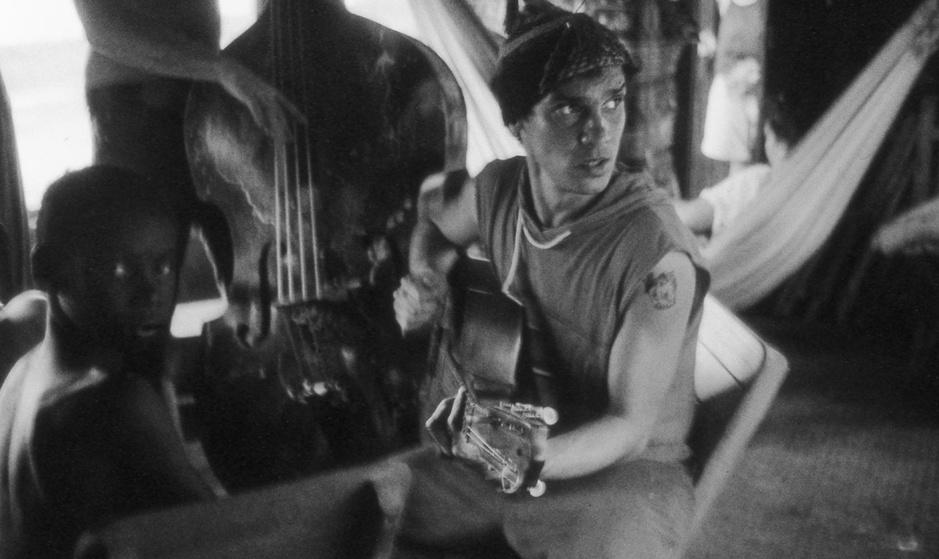
Foto de Emanuel Bovet.
Hoy para muchos acudir a un concierto de Manu Chao, escuchar sus viejos discos o sorprenderse con las tres nuevas canciones, es lo más cercano para imaginarse en un show de la Mano Negra. Quienes tuvieron la oportunidad de bailar junto a estos franceses en vivo y directo seguro recuerdan todo a la perfección, ya que nunca se ha escuchado hablar sobre un reencuentro de la original Mano Negra, de aquellos The Clash del noventa, de esos chicos del barrio que revolucionaron el ámbito musical, cuando comenzaron su carnaval en el Metro parisino.
Conoce la historia del Acid House de la mano de Carl Cox, Larry Heard y más
Este texto fue publicado originalmente en Thump, nuestra página de cultura y música electrónica.
Después de 14 años de producción, el documental They Call It Acid por fin verá la luz y contendrá mucho material inédito. Esta obra fue realizada como "una labor de amor" y está narrado por Robert Owens, el vocalista de Finger Inc. La música que acompaña al trailer —publicado esta mañana— está producida por "Evil" Eddie Richards.
La historia de They Call It Acid se centra en el nacimiento del fenómeno rave y los métodos de represión que desplegó el gobierno británico con su "Operation Alkaline", en la cual invirtieron millones en la policía para "neutralizar" la movida que generó el acid house. Este documental vendrá de la mano de entrevistas con Carl Cox, Larry Heard, Derrick May, etcétera. Habrá mucho material inédito, grabado en fiestas ilegales y redadas policiacas; material que el director, George Mason, pasó diez años recolectando durante el nacimiento del acid house, a finales de los ochenta. Podemos apostar a que casi todo el contenido del documental será material nunca antes visto.
Bowie, Elvis y Lemmy: ¿cuál de estos famosos tenía la peor dieta?
Algunas celebridades son más famosas que otras por su manera de beber y consumir drogas. Hunter S Thompson, por ejemplo, supuestamente inhalaba cocaína en el desayuno, y así repetidamente, durante todo el día, antes de meterse un ácido después de comer. Se dice que, Bowie sobrevivió con una dieta a base de coca, leche y pimientos rojos durante un tiempo, mientras que Lemmy se jactaba de beber una botella de Jack Daniel's todos los días.
Todos estos cuentos se añaden a los mitos que rodean a estos artistas, pero realmente: es exponer demasiado a tu cuerpo. ¿Cómo les afectaba vivir con ese estilo de vida, y cómo duraron tanto tiempo?
Para averiguar que famoso tenía la peor dieta, teniendo en cuenta que ninguna es buena, hablé con algunas personas que saben del tema: Dr. Henry Fisher, Director del think-tank de políticas de drogas Volteface; George McBride, Jefe de Defensa en Volteface; Harry Shapiro, editor de Druglink y director de publicación en Drugscope; y Petronella Ravenshear, nutrióloga de Chelsea Nutrition.
ELVIS: PEPSI,TOCINO, CREMA DE CACAHUATE, SÁNDWICHES DE PLÁTANO Y MEDICAMENTOS RECETADOS

Elvis (Foto: MGM Inc, vía)
Es difícil saber todo lo que Elvis consumió en el período más oscuro de su vida, pero para empezar: bebió tanta Pepsi que supuestamente los camiones de distribución de Pepsi se las llevaban directamente a Graceland en grandes cantidades. El elemento básico de su ingesta diaria de alimentos era el "Fool's Gold Loaf", un rollo de pan de 30 cm de largo, relleno de tocino, crema de cacahuate y mermelada de fresa. Cada uno contenía 42.000 calorías, y en sus últimos días se comía dos al día, junto con pequeños bocadillos de hamburguesas y pan blanco frito. Su ingesta calórica se situó en un estimado de 94.000 al día. Un elefante asiático consume sólo 50.000.
Y luego estaban los medicamentos recetados: Diazepam, Methaqualone, Phenobarbital, Ethchlorvynol, Etinamato, Codeína, analgésicos y sedantes potentes como Dilaudid, Quaaludes, Percodan y Demerol. La evidencia mostró que siete meses y medio después de la muerte de Elvis, de enero a agosto de 1977, su médico le escribió recetas para al menos 8.805 pastillas, tabletas, ampolletas e inyectables.
"Para algunos de nosotros, el gluten actúa como un opiáceo, es decir, como la heroína o la morfina, y no sólo puede ser muy adictivo, sino que también puede tener un efecto sedante", explica Petronella Ravenshear. "Su dieta de alto contenido en grasa, azúcar y en carbohidratos no sólo es tóxica para el hígado y el corazón, también es fatal para el microbioma. Los efectos a corto plazo serían estreñimiento, cambios de humor y depresión. El efecto a largo plazo sería la muerte. "
Además de toda esa sedación alimentaria, consumía muchos sedantes, y su obesidad cambió la forma en que las drogas lo afectaron. "En términos de peso corporal, si alguien pesa el doble que cualquier otra persona, hay mucha más masa y necesitaría más drogas para lograr el efecto deseado", dicen los chicos de Volteface. "Si alguien es pequeño, una dosis mucho menor tendrá un efecto similar. También si alguien lleva una dieta así de pesada, esto tendrá un efecto en las drogas que consuma, cómo se metabolizan, cómo se mueven en el cuerpo y por cuánto tiempo se quedan".
¿Qué tan peligrosa es esta dieta? 5/5
"Él consumía estimulantes, sedantes. El riesgo de sobredosis es muy alto, y también es un problema dejarlos," dice a Harry Shapiro. "Si tu cuerpo te permite dejar de consumir todo esto, vas a vivir un infierno. Elvis sufrió un ataque cardíaco masivo y fue causado más por la dieta que por las drogas. No sé cuánto sufrió físicamente pero el dolor emocional…"
ERNEST HEMINGWAY - DEATH IN THE AFTERNOON (MUERTE EN LA TARDE)
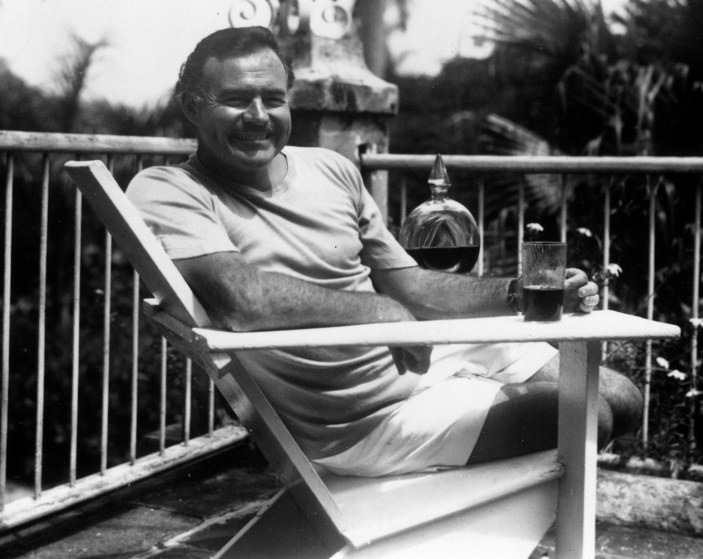
Ernest Hemmingway (Foto: US National Archives and Records Administration, vía)
El famoso bebedor Hemingway odiaba muchas cosas, a William Faulkner y a las mujeres, pero le encantaba su absenta, tanto que inventó su propio cocktail de absenta, Death in the Afternoon (Muerte en la tarde) , que bebió con frecuencia, junto con un montón de otros cócteles. En un libro de cócteles de 1935 escribió: "Vierta un chorrito de absenta en una copa de champán, agregue champán helado hasta que obtenga la consistencia lechosa opalescente adecuada. Beba de tres a cinco lentamente".
"Ahora, ese coctel es bastante bueno", dice el equipo de Volteface. "Pero si era lo primero que consumía y con el estómago vacío era obvio que iba a tener consecuencias. El absenta es muy fuerte, contiene 70 o 80 por ciento de etanol." Alguien que consume tanto en un día es dependiente del alcohol. "
¿Qué tan peligroso es? 3/5
"De hecho, el alcohol es más peligroso a largo plazo que las drogas, en muchos sentidos", dice Harry. "La heroína, por ejemplo, no es una droga particularmente perjudicial como la gente piensa, no es como el alcohol, no afecta a los órganos vitales: el hígado, el cerebro, los riñones, el corazón. Pero el alcohol y la CocaCola ponen al cuerpo bajo mucha presión, la frecuencia cardíaca y la presión arterial se ven afectadas. También el alcoholismo afecta la salud mental. Por supuesto, Hemingway se disparó."
LEMMY: JACK Y COCA-COLA; SPEED Y CIGARROS
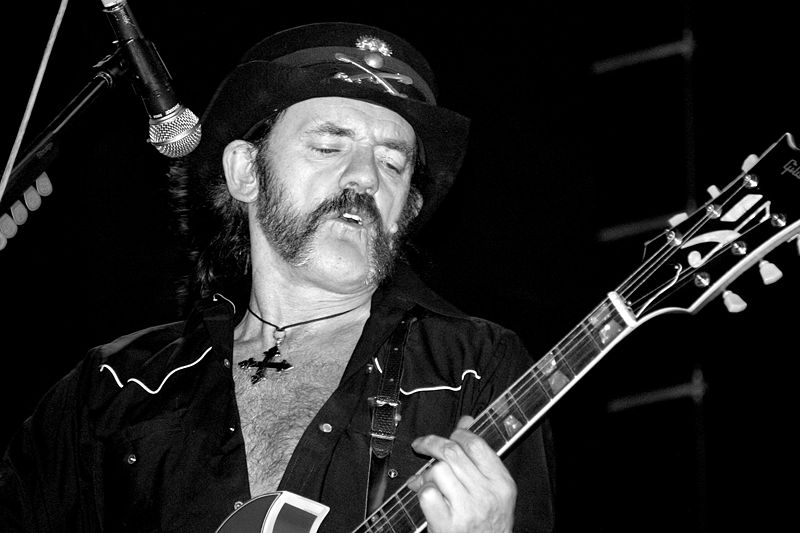
Lemmy (Foto de Flickr user Alejandro Páez, vía)
Kilmister se metió una dosis diaria de JD con Coca, speed y cigarros por más de 40 años. Llevándolo a la muerte, su manager dijo que iba a bajarle a sus vicios, pero que se seguía bebiendo dos botellas de vino al día. Pero bueno, al menos él sí comía. Nada de verduras. Espagueti frío, papas frías, bistec frío. Hay nutrientes allí en alguna parte.
"Aunque que comer sano no contrarresta el efecto de las drogas, te ayudará a recuperarte más rápido y con eficacia. En el caso de Lemmy, él no comía bien," dicen los chicos de Volteface. "En términos de cuanto afecta el speed tu salud mental, a largo plazo las personas que consumen anfetaminas pueden sufrir de psicosis por anfetaminas, especialmente si consumes grandes cantidades. Hay que preocuparse si consumes speed todos los días junto con Jack y Coca-Cola, que es un montón de azúcar. Pero como su preocupación principal probablemente no era comer bien, no le preocupaba la cantidad de azúcar que consumía hasta que obviamente le dio diabetes y entonces sí se convirtió en una gran preocupación."
Lamentablemente, Lemmy murió de cáncer, lo cual no es sorprendente para Fisher o McBride.
¿Qué tan peligroso es ? 3/5
"Probablemente puedas hacer esto cuando estás en tus veinte y treinta años, pero cuando tienes cincuenta o sesenta eso sí es realmente peligroso", dice Harry. Lemmy fumó mucho y bebió mucho y murió a causa de un cáncer agresivo. Una vez más, creo que el problema serían los cigarros y el alcohol más que cualquier otra cosa ".
DAVID BOWIE: COCAÍNA, CAFÉ, MARLBORO, LECHE Y PIMIENTOS ROJOS

David Bowie (Foto de Flickr user Auréola, vía)
De acuerdo con el biógrafo David Buckley, quien escribió Strange Fascination: David Bowie: The Definitive Story, la dieta de Bowie en 1976 consistía casi exclusivamente en pimientos rojos, cocaína y leche entera. Después Bowie dijo que apenas se acordaba de esta época de su vida, lo cual no suena muy bien.
Buckley escribió: "Mientras planeaba el seguimiento de Young Americans, Bowie se sentaba en su casa con un montón de cocaína de alta calidad encima de la mesa de cristal, un bloc de dibujo y una pila de libros. Psychic Self-Defense de Dion Fortune era su favorito. La autora describe el libro como un "resguardo para protegerse contra la malevolencia paranormal". Las instrucciones del Psychic Self-Defense ("Poner fin a todas las conexiones con originadores sospechosos") parecen un paradigma para el modo aislado y sospechoso en el que Bowie vivió durante este período, sin contar, por supuesto, uno de los principios clave de Fortune: "Manténgase alejado de las drogas".
"La cocaína es un supresor del apetito, por lo que tiene sentido que sólo comiera pimientos rojos y leche. Le ayudaba a no querer romper su dieta.", explican los chicos de Volteface. "Además de eso, la leche tiene nutrientes por la grasa. Es mejor que nada. La cocaína es, por mucho, la peor parte, obviamente. Su salud mental sin duda se iba a ver afectada ya que la consumía todos los días. Podrías tener una borrachera de cocaína y sufrir de paranoia y ansiedad y delirios paranoicos. Pero si te metes varios gramos al día es casi inevitable que sufras de delirios paranoicos en algún momento.
Esto, por supuesto, se refleja en la conducta de Bowie tal como se describe en el libro de Buckley.
En cuanto a la leche y los pimientos, "La dieta de Bowie le impidió morir de hambre, pero era muy baja en vitaminas y minerales, así como en aminoácidos", explica Petronella Ravenshear. "Su dieta lo llevó a tener múltiples deficiencias, así como la ruptura muscular y malestar general. Tal vez pensó que obtendría la proteína que necesitaba de la leche y la vitamina C de los pimientos, y pensó que era todo lo que necesitaba para mantenerse con vida. La leche contiene demasiado calcio y no es suficiente magnesio y el magnesio no sólo es vital para la energía, sino también para la relajación. La falta de magnesio hace que el cuerpo sea literalmente incapaz de relajarse y puede causar calambres musculares y problemas cardíacos, incluyendo presión arterial alta. Esta dieta también es baja en B12, que es vital para el sistema nervioso, la digestión y el sueño.
¿Qué tan peligroso es? 3/5
Nadie sobreviviría a largo plazo con esta dieta, pero este menú específico sólo duró un corto período en la vida de Bowie. "Bowie era un consumidor de drogas regular, pero tenía cáncer de pulmón porque era un fumador crónico. La bebida y el tabaquismo son más letales que las drogas y representan más que otra cosa una amenaza de sobredosis," dice Harry. "Es probable que el alcohol y los cigarros causen daños a largo plazo".
HUNTER S. THOMPSON: TODO AL MISMO TIEMPO
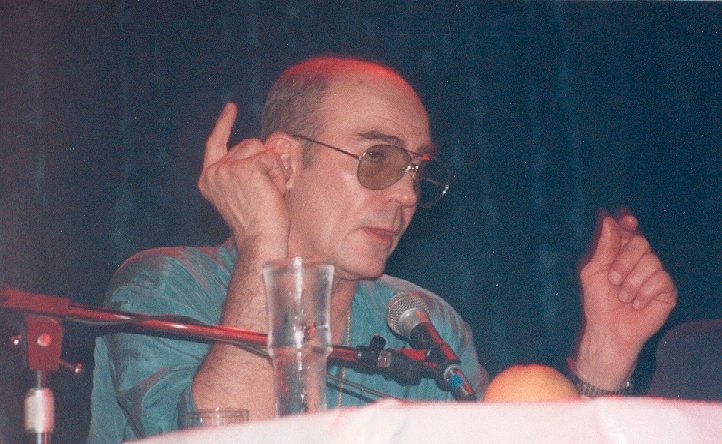
Hunter S Thompson (Foto de Wikimedia user Rs79,vía)
En este caso es más sencillo publicar su rutina diaria como lo describe E Jean Carroll en el primer capítulo de su libro de 1994 HUNTER: The Strange and Savage Life of Hunter S. Thompson:

"Basándonos en esta dieta sabemos que por lo menos recibía suficientes nutrientes", dicen los chicos de Volteface. "No sufría del mismo problema que David Bowie de la falta de variedad en términos de comida. Pero consumía muchísimas drogas. Simplemente el hecho de meterse ácido todos los días. Si consumes psicodélicos por lo general hay un momento en que ya no te hacen tanto efecto. Después de meterse tanto, ya no iba a tener alucinaciones, de la misma forma que alguien que lo hace esporádicamente. Pero puede seguir duplicando su dosis. No hay sobredosis con el LSD, por lo que sólo puedes seguir tomando más y más. Puedes generar una tolerancia a las drogas, él claramente tenía una resistencia ya que consumía muchísimo. Probablemente consumía tanto porque si no lo hacía podría darle el síndrome de abstinencia o experimentar algún tipo de efectos secundarios.
"Bebía una cantidad enorme de alcohol y también consumía Halcion, que es una combinación bastante peligrosa. Puede causar la muerte. El funcionamiento del hígado de Hunter S. Thompson es probablemente tan misterioso como el funcionamiento de su cerebro. Le fue muy bien al sobrevivir tanto tiempo con esa dieta".
La riqueza es un factor muy importante para a los que llevan este estilo de vida. "Tenía atención médica y gente a su alrededor para apoyarlo", agrega el equipo de Volteface. "Muchas personas que consumen grandes cantidades de drogas y no duran tanto, o incluso cantidades más pequeñas de drogas y no viven tanto tiempo, es en parte porque no tienen ese apoyo para ir a los mejores hospitales. Es mucho más fácil ser un drogadicto adinerado que ser un drogadicto sin dinero ".
¿Qué tan peligroso es? 4/5
"El consumía de todo, vivía en un carrusel de químicos", dice Harry. "Él no murió directamente por las drogas, pero se disparó. Es imposible saber cuanto daño le estaba haciendo a su cuerpo, pero probablemente no estaba estable. La coca y cafeína le hubieran causado problemas cardiacos. No me hubiera gustado estar cerca de Hunter S. Thompson, podría haber sido completamente impredecible con todo ese cóctel de drogas encima. Tiene que ver más con tu estado mental que con tu estado físico. "
The Undeniable Beauty of Low-Fi Gaming
Back in November, Sony released the PS4 Pro, a more powerful system promising improved graphics, as well as 4K resolutions and High Dynamic Range Color. With the Pro, Sony is banking on the idea that people will see the advantages in a technology that's far from mainstream, and not yet standardized.
Microsoft, Sony's biggest competitor, is also aiming at this market with Project Scorpio, a system they've said will bring even greater performance. It's a gamble that's proven useful before—the Xbox 360 set HD as a minimum standard long before HDTVs were mainstream—but there's a sense of insecurity surrounding all this talk of 4K. People are already claiming that his generation has become outdated, and the easiest way to assuage those fears is to give them more power, and bigger numbers. These large companies are deeply invested in the idea that greater technology means better art.
Meanwhile, there's a growing number of artists intentionally pushing in the opposite direction. There's an increasing appreciation for the artifacts and flaws of older technology, in the same way that the pristine quality of digital sound has influenced a resurgence in vinyl and cassettes.
Read more on Waypoint
Despite Progressive Neighbors, Hong Kong Remains Backward on LGBTQ Rights
When Hong Kong residents Yan* and Janice* told their church counselor they were lesbians, he invited them to pray the gay away with the pastor. At a quiet church squeezed between bustling mega malls, they say the pastor then told them that homosexuality was wrong, and that they needed to ask God to clean them. After asking them for money, he told them the only way to be clean of gayness was through vomiting and fainting from exhaustive prayer.
Their experience is illustrative of the ex-British colony's complicated relationship with its LGBTQ citizens. Even as neighbor Taiwan makes strides toward legalizing gay marriage, people in Hong Kong take an extremely traditional view towards sex and marriage that extends to the LGBTQ community. Hong Kong doesn't protect its gay population through anti-discrimination laws, despite its development as a free economy separate from mainland China; in Taiwan and Macau, anti-discrimination laws plainly protect LGBTQ citizens from workplace discrimination, and those of the former extend to schools.
What's more, Hong Kong's government doesn't just ignore efforts to support its gay community—it sometimes actively works against them. Some have claimed that city social workers occasionally (and unofficially) refer youth to therapists who practice gay conversion therapy, which attempts to convert people to heterosexuality through shame-driven tactics that can leave patients deeply psychologically damaged. And through last year, the government provided funding to Post Gay Alliance, a fundamentalist Christian organization chaired by a psychiatrist named Hong Kwai-wah; though the city also funds pro-gay causes, Post Gay Alliance promotes "post gay" ideology to the city's youth, a practice closely linked to conversion therapy.
Hong Kong's general stance toward homosexuality stems from the outsized influence of Christianity and Catholicism in the city. While only some 5 percent of Hong Kong citizens identify as Catholic, making it a minor religion in a region dominated by Buddhism and Taoism, the church's roots run deep. "Its members hold a lot of social resources and have an influential social status," said Julia Sun, a prominent sexual rights advocate who founded a Chinese forum for accurate sex advice called Sticky Rice Love.
She added that many of the city's schools have a Christian background; according to Hong Kong's Yearbook, an annual compilation of statistics published by the government, Christian schools outnumbered secular schools in Hong Kong by more than double in 2015. Christian schools tend to perform among the region's best on public exams, which makes them preferred choices for parents—but the education their children receive is deeply conservative.
"Christian schools here teach students that masturbation and homosexuality are sins," said Tommy Chen, an LGBTQ advocate with Rainbow Action, the city's only gay community center. "Although most Hong Kongers are not Christian, because of Christian education, they're sexually conservative—and this makes the situation much worse than in mainland China," Chen said. Mainland China is Communist, and the government there does not allow Christianity ideals to thrive.
Those religious roots influence the city's complex relationship with gay rights. On one hand, Hong Kong has pride parades and out pop stars, and in a 2012 survey of more than 1,000 randomly selected working Hong Kongers, 50 percent said they were "accepting" of LGBTQ people. On the other, in a separate survey of 611 adults in November 2015, 68 percent said they agreed with the idea that society should tolerate anti-homosexual views.
One example of how those attitudes manifest comes via the practice of Hong Kwai-wah. In 2011, Hong was invited by the government's Social Welfare Department to speak to registered city social workers, which many felt amounted to a de-facto endorsement of his "post gay" therapeutic practice on the part of the Social Welfare Department. The invitation caused international controversy, including a protest in New York. Hong was hired by Gloria Lee, the head of training for the department at the time; a spokesperson would not let her respond to a request for comment. Since 2011, the government has continued to fund Hong's Post Gay Alliance and allegedly refer youth to conversion therapists.
Hong denies that he's ever practiced conversion therapy, and said that he has been practicing "post gay" therapy for the past 30 years, a counseling approach where the "objectives are to enhance self image, remove guilt and shame resulting from [a client's] sexual orientation, and to gain emotional satisfaction from other relationships such as family, friends, heterosexual, or spiritual relationships, so that they can experience joy and peace in their lives," Hong told me.
Hong's organizations have been careful to avoid using the term "conversion therapy" in describing what they do. New Creation Association, another organization chaired by Hong, has said on its website that it can help people "give up a lifestyle of homosexuality" through counseling. Hong denies that the primary objective of "post gay" therapy is to practice abstinence from gay sex. "This approach is too negative and ineffective. Sexual abstinence with [the] same sex is just a natural consequence of positive changes in other areas of [a client's] life," he said.
While Hong gave little detail on what happens during a "post gay" therapy session, he said that he uses a therapeutic technique known as Sexual Attraction Fluidity Exploration in Therapy, or SAFE-T. It's thought to be a revival of gay conversion therapy that affirms sexual orientation is changeable, albeit with a softer name than "conversion therapy."
"We had noticed [Hong's practice] for quite some time," said Chen, the Rainbow Action advocate. "But it was international news in 2011, because Hong Kong may have been the first government in the world to commission conversion therapy."
Though Hong denied that he's ever practiced gay conversion therapy, Yeo Wai-wai, a sexual minorities advocate with the Women's Coalition of Hong Kong, said she worked with a young man five years ago who went to Hong after a referral from his government social worker. Hong prescribed the young man antidepressants to treat his homosexuality, Yeo said. "He didn't find himself 'converted' at all," said Yeo, "but more and more unhappy throughout therapy."
When asked whether the Social Welfare Department still refers its youth to conversion therapists and what they do to support LGBTQ youth in crisis, a spokesperson from the department's Information and Public Relations Unit wrote that "knowledge from multiple perspectives is essential for social workers to make professional, comprehensive, and independent assessment on their cases." They did not affirm or deny whether the department refers youth to conversion therapy, or comment on whether they will publicly condemn the practice. As for Hong, the spokesperson simply wrote that "Dr. Hong Kwai-wah was once invited in 2011 to deliver a talk to provide our social workers with information to enable them to have a better understanding of sexual identity and sexual attraction among the youth, and the skills [sic] when working with them."
Unlike a wide variety of American medical bodies and the Obama administration, Hong Kong's government itself has yet to officially condemn gay conversion therapy, and a government spokesperson declined to comment why. Taiwanese officials published a plan to ban conversion therapy this month (though Macau also hasn't condemned the practice). The chairman of the city's Social Workers' Registration Board, Lun Chi-wai, said that he could not comment on this issue; the Registration Board is the city's official licensor for social workers.
While conversion therapy is not particularly common in mainland Chinese society, when it is practiced, it is hidden from public view. A doctor in mainland China who openly practiced the therapy sparked protests in 2014 and was brought to court in a landmark case.
*Names have been withheld to protect sources' identities.
Follw Justin Heifetz on Twitter.
The White House Threw Its Full Support Behind the March for Life
If it weren't for the hundreds of "Defund Planned Parenthood" signs scattered everywhere, the annual March for Life in Washington, DC, could have been mistaken for a family-friendly country music festival. Thousands of people, mostly families and church and school groups, gathered by the base of the Washington Monument on Friday as a DJ blasted pop-country songs onstage and guest speakers discussed the importance of the fight against abortion.
For the past 44 years, the March for Life has taken place in DC on or near the anniversary of the landmark 1973 Supreme Court decision Roe v. Wade. The event, organized by the March for Life Education and Defense Fund, has had a steady attendance over the decades, but this year there was an added feeling of excitement. President Donald Trump earlier this week promised to name his nominee for Supreme Court justice next week, someone dedicated to overturning Roe v. Wade, and the administration's commitment to the cause was demonstrated by an appearance by Vice President Mike Pence, a longtime abortion foe who as governor of Indiana signed some of the most restrictive abortion laws in the nation.
"It's the best day I've ever seen for the March for Life, in more ways than one," Pence told the crowd. "I am humbled to stand before you today to be the first vice president of the United States to attend. Today, because of all of you and the many thousands who stand with us in marches like this all across the nation, life is winning again in America."
Continue reading on VICE News.
Could the Government Ban Strikes?
It would be foolish to say an end is in sight. But industrial tensions have been scaled back on Southern – Britain's worst performing railway – for the first time in a year. After five days of total shutdown, drivers' union Aslef has suspended its strikes and overtime ban pending ongoing talks brokered by the TUC. This epic battle over the de-skilling of conductors and the expansion of driver-only trains could – and that's still just a could – be resolved by a dose of good, old-fashioned industrial relations.
Both drivers and conductors remain in dispute, but the irate commuters who urged Aslef to call the strike off before new talks have finally got what they wanted. With reports this week that Southern could be stripped of its contract, there could be vindication for those who always said both sides were equally to blame.
But this is unlikely to appease the right wing press, for whom workers have always been depicted as the real enemy. As talks between unions and rail bosses resumed on Monday, the Evening Standard splashed with the headline: "LONDON WANTS CURBS ON RAIL STRIKERS". The article referred to an Ipsos Mori poll which asked whether train drivers should "have their right to strike limited" or "be able to strike as any other industry". Sixty-two percent of Londoners said the latter. But the poll also found that support for limits on NHS staff, train drivers and teachers were all higher in the capital than in the country as a whole.
The Standard is not the only paper to big up proposals to curb transport strikes. A Sunday Times editorial in December urged that the "ability of unions needs to be curtailed". Meanwhile, the Sunday Telegraph reported that Theresa May was facing a "backlash" from her own MPs because she would not introduce such laws herself.
On Tuesday, Croydon South MP Chris Philp proposed his "ten minute rule" bill – a piece of legislation suggested by a backbench MP – which would force workers to run a 50 percent service on strike days, and allow High Court judges to determine if they could go ahead at all.
Read more: How Did the Rail Union Become So Powerful?
Unsurprisingly, Philp's proposal was easily defeated. It would be simple then to forget all about it and go off into the horizon whistling the Internationale in celebration of a rare victory against the Tories and the bourgeoisie. But with media demands for strike bans and 120 Tories turning out for Philp's wacky backbench debate, it doesn't take a doom merchant to wonder if there's more yet to come. And perhaps it's time to consider that perhaps Philp isn't a wacky maverick at all, but a useful outrider laying the ground for yet another attack on our rights at work.
It's not just lefty conspiracists saying as much. According to the Standard, ministers "say privately they are considering adopting the measure". Transport secretary Chris Grayling has refused to rule it out. It would hardly be surprising if his Department for Transport was keen: its passenger services director Peter Wilkinson is on record speaking of "breaking" unions and threatening "punch-ups".
The private rail companies aren't far off either. Southern used the same measures proposed in Philp's bill – the High Court and the argument that strike action must be "proportionate" – when it tried to get the drivers' strike declared illegal under EU law in December.
But before we get ahead of ourselves, back to that poll. The Standard didn't mention it, but train drivers, NHS workers and teachers are already set to face an extra hurdle before they can strike – thanks to the 2016 Trade Union Act. Along with fire brigades and border controls, their strikes will be declared illegal if fewer than 40 percent of eligible voters give them their backing. That's on top of a 50 per cent turnout rule for all strikes. "These modernising reforms will ensure strikes only happen as a result of a clear, positive and recent decision by those entitled to vote," employment minister Nick Boles said at the time.
Unions know the new rules will lead to fewer national walk-outs by nurses, teachers and local government workers. But the railways are a different kettle of fish. Privatisation limits disputes to one route, so any dispute will hit home harder. And a unique culture of rank-and-file organising means rail unions have bucked the trend of declining worker influence. Ballots typically see turnouts and majorities far in excess of the new thresholds: 78 percent of Southern conductors backed the current strikes, for instance.
But there are many within the labour movement who think we haven't seen the half of what might be coming to curb strike action. Labour shadow Cabinet Office minister Ian Lavery has said Chris Philp MP's Bill was part of a "pincer movement" of Tories attacking workers' rights. Another rail union source has speculated that "ideologues in the Department for Transport or the Conservative party" could well have concluded that "thresholds haven't worked and we're going to have to ban strikes on railways and buses".
One Department for Transport boss is on record speaking of "breaking" unions and threatening "punch-ups".
But if there's such a conviction at the top, why would the government wait? Perhaps we should look to the very poll the Evening Standard cited that's supposed to tell us the public would be on board. Across Britain, it shows that only 37 percent would support restricting train drivers' right to strike – which could refer to what's already the law. Seventy-seven percent think unions are "essential to protect workers' interests", most think they don't have too much power, and most disagree with the assertion they're controlled by "extremists and militants". Introducing an effective ban on strikes would surely provoke outrage. But our lawmakers know there will always be less outrage if extreme policies are gradually eased into the public consciousness.
Take the case of the emergency services: in 2013 Tory MP Tobias Ellwood called for them to be merged under a new homeland security department. Since then, the Fire Brigades Union has repeatedly raised concerns that fire crews are being expected to respond to medical emergencies despite not having sufficient training. If a full merger follows, banning fire and ambulance crews from striking would suddenly seem a lot less radical – because the police are banned already.
You'd think the unions would welcome this week's news that Southern has defaulting on the "remedial" plan agreed with the DfT. Rail unions RMT, Aslef and TSSA all support renationalising the whole network. But those comments from the DfT's Peter Wilkinson have made them think it's all being driven from Whitehall. Re-nationalisation, which is reportedly being considered, could make things worse as well as better – in the short-term at least.
Southern, after all, is only the beginning of a rail dispute that's about to spread nationwide. The 2011 McNulty report recommends driver-only operation as "default" for Britain's railways. Merseyrail has already ordered trains without the capacity for guard-operated doors, and the new Northern franchise plans to roll out the same. If the determination of the rail unions forces a compromise over Southern, we should expect even more of an effort from bosses and ministers to ensure they never lose again.
Naukowcy twierdzą, że psy kochają reggae
Psy są trochę jak my, ludzie. No cóż, wciąż nie wypracowaliśmy skutecznego sposobu na zapobieganie katastrofom i w zasadzie na chwilę obecną jest bardzo źle, ale jest jedna rzecz, która nas łączy z czworonogami: reggae. Według najnowszych badań brytyjskich naukowców, psy wykazały „najbardziej pozytywne zmiany zachowań" słuchając właśnie tego gatunku. Lubią także soft rock, a warto wspomnieć, że poza tym, do wyboru miały także pop, brzmienia Motown i muzykę klasyczną.
W raporcie opublikowanym na portalu BBC wspomina się, że podczas słuchania reggae psom spada poziom stresu. Poza tym, zwierzaki podobno mają także „swoje własne preferencje muzyczne". Jeśli zatem chcecie zaprzyjaźnić się z jakimś jamnikiem przybłędą, puśćcie mu coś Boba Marleya albo Snoop Liona. Z całą pewnością pomoże. W końcu spece z uniwersytetów nie mogą się mylić.
Więcej ważnych informacji znajdziesz na na Noisey Polska
Photos of Drunk Witches Racing Each Other Down A Snowy Alpine Slope
All photos by David Zehnder
This article originally appeared on VICE Alps
According to a Swiss legend, there was once a witch living near the picturesque Alpine village of Belalp. The witch was married but cheated on her God-fearing husband with a young man. The two lovers secretly met by transforming into black ravens, soaring through the crisp mountain air. When her devoted husband began to suspect something, the witch decided to get rid of him. The moment he climbed onto an old cherry tree to pluck cherries, she flew over the tree and dropped a rancid black cherry in his eye. The man lost his sight, fell down and died. The legend has it that the town dealt with the murder quite radically – she was made to confess after being tortured and was subsequently sentenced to death and burnt at the stake.
Normally every January, tourism in Belalp experiences a lull. That's why 35 years ago, hoteliers and ski instructors from the region decided to battle that quiet spell by organising a ski race commemorating the witch and her husband. Having locals and tourists alike dress up as witches, get drunk and ski down an icy slope proved to be exactly what the area needed during the slower weeks – despite the bad weather, over 1,300 people joined the witch race on the 14th of January this year. The race itself isn't about time, but about style. And about doing as many shots as possible, which explains why most witches don't make it to the finish line but get stuck somewhere on their way down the slope.
Local photographer David Zehnder was there to document this year's event.



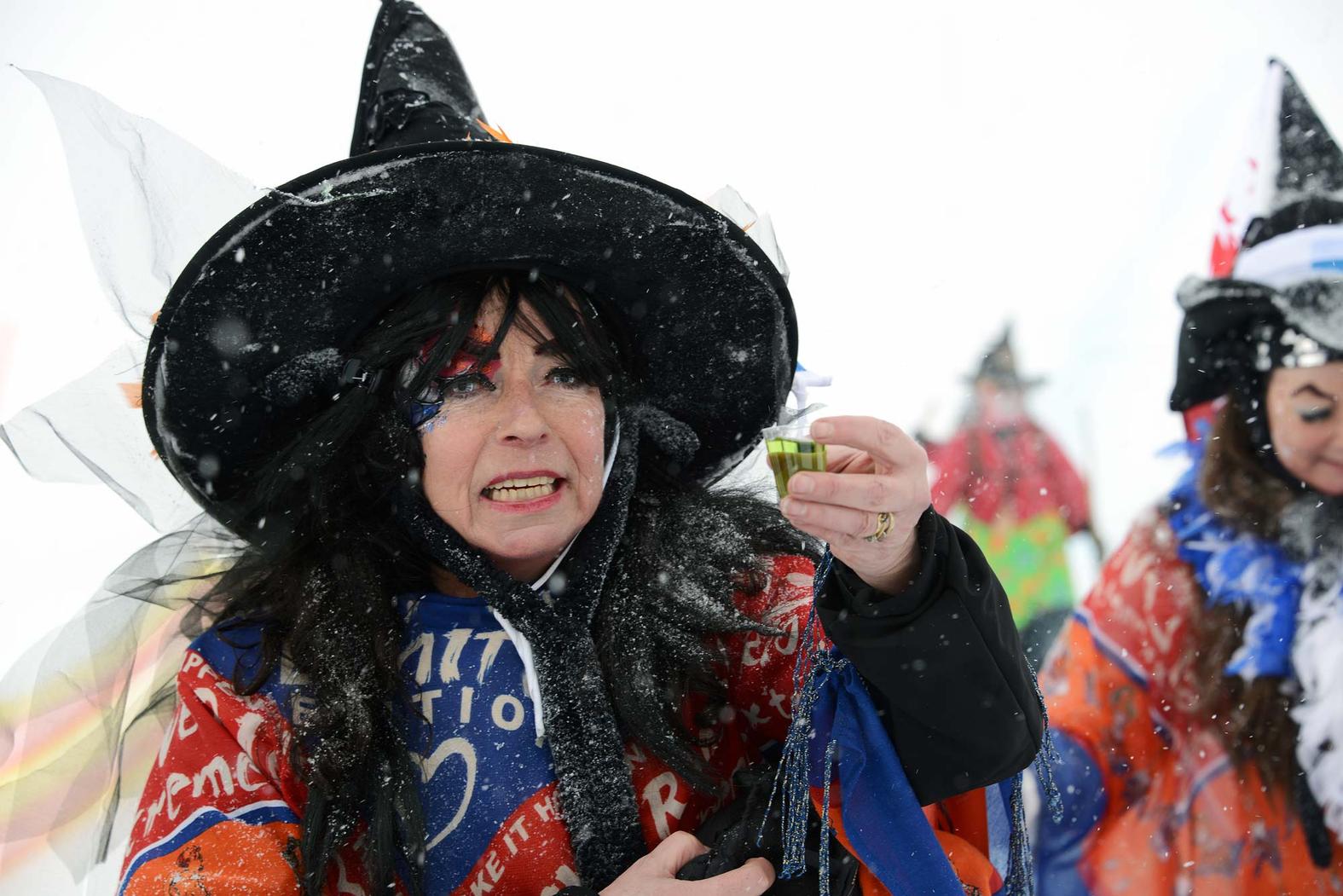

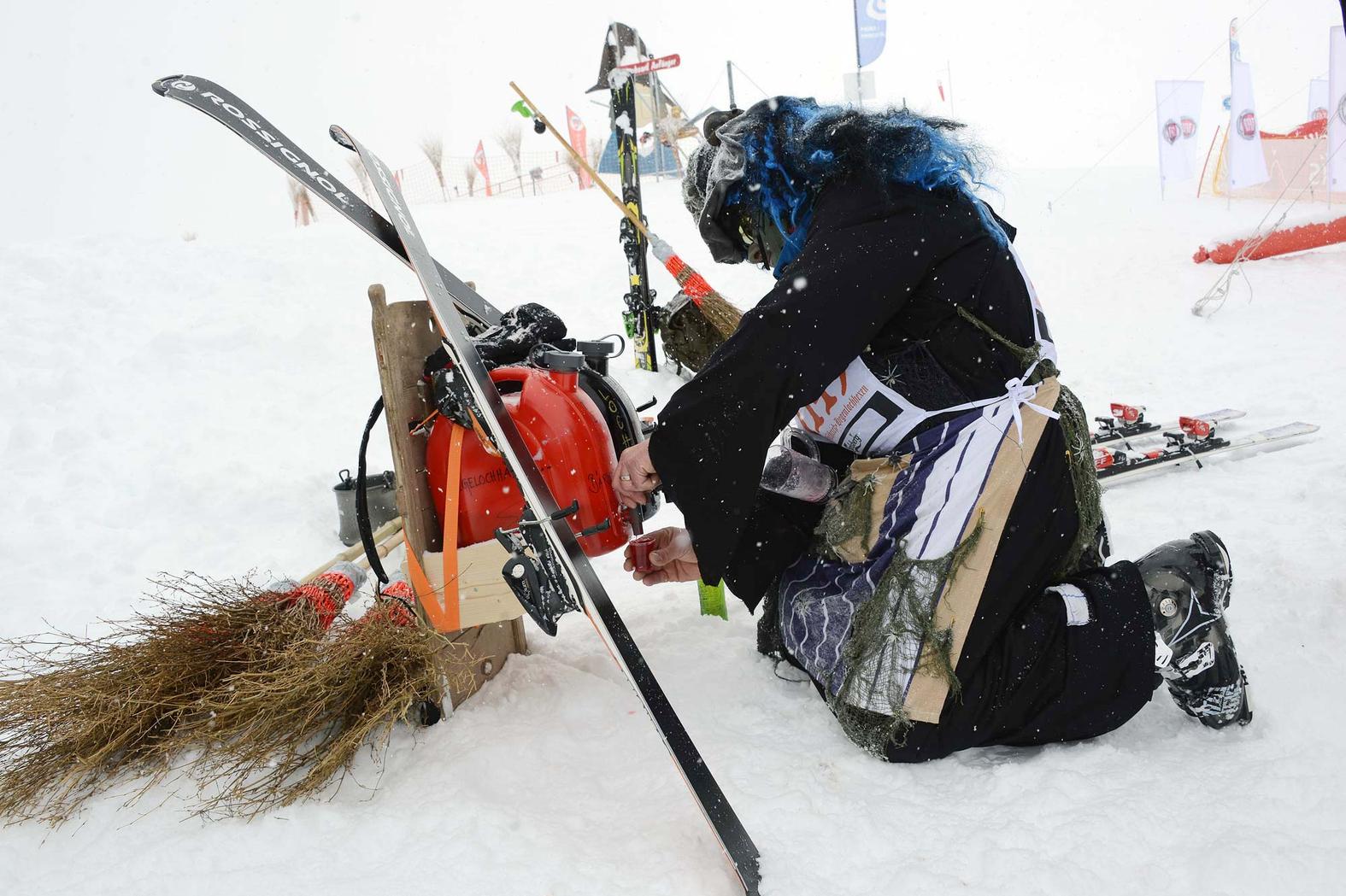
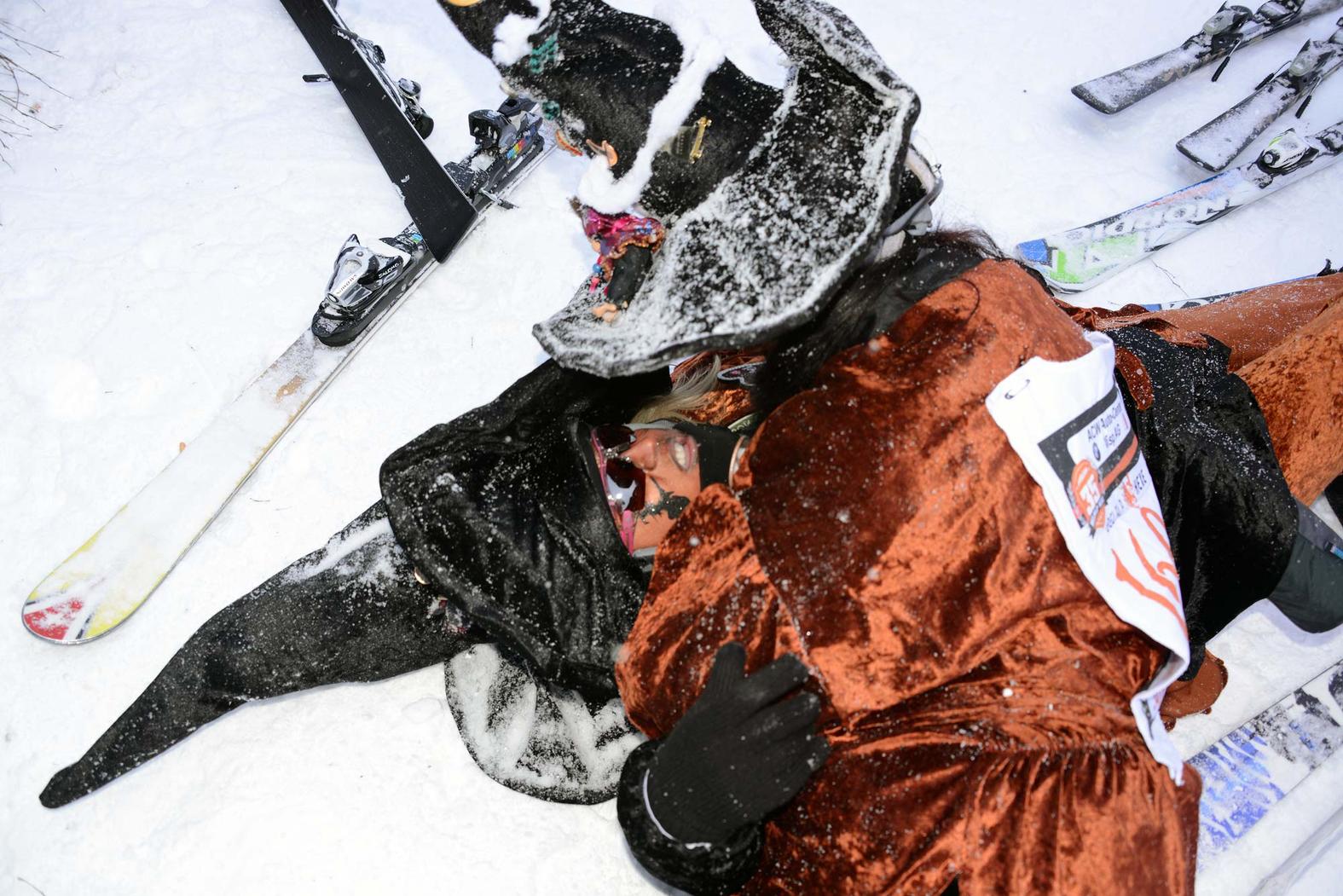




More on VICE:
The Strange Swiss Custom of Dressing Up as a Bush and Throwing Women in Wells
How 'T2 Trainspotting' Director Danny Boyle Tried to Make Filmmaking Less 'Colonial'
Top image: Young Fathers and Danny Boyle. Photo by Imogen Freeland
There's a mountain in Edinburgh, Scotland, adored by locals. It's said that its name, Arthur's Seat, is taken from the legends of King Arthur. Couples walk up it and leave love locks on the metal bars at the top. The view from up there is utterly beautiful.
In T2 Trainspotting, a rejuvenated Renton, played by Ewan McGregor, now clean from heroin, runs up it easily, followed by a sweaty Spud, played by Ewen Bremner. Quitting smack is just about finding a new obsession, explains Renton. Running could be it. At the top, the pair collapse and look out over Edinburgh—the streets they were sprinting through, screaming, 20 years ago; the city with a drug culture made them disappear into carpets and be vomited out of toilets.
"Holy God! It's like Rio or Cape Town," says Danny Boyle, enthusiastically, bouncing on his toes. "There's this incredible natural thing—a mountain, really—and the whole historic city is built in a loop around it. It's a good steep walk up with extraordinary views. You can get killed up there in bad weather—people fall off. You feel it's got this huge natural force. We had a beautiful day when we were filming there."

Renton and Spud looking over Edinburgh. Still from 'T2: Trainspotting'
Most of Trainspotting was spent inside—rowdy pubs, perspiring clubs, drug-den apartments. It was primarily filmed in Glasgow. Now, the characters are older and, for the most part, although still in love with drugs, off heroin. T2 also explores Edinburgh, the city, which seems to have evolved since the first film.
"The city doesn't change that much, because it's a historic city; it's protected by that. It's the energy of the city that's different," says Boyle. "The student population now is huge compared to 1996, when we were there. At that time, it was only really posh medical students, and still is, but there's a bigger mix of them now. It feels more vibrant and more European. It's more fun to be in, and I really liked living there for six months. Edinburgh seemed a bit twee before."
I'm in a hotel in central London with Boyle and Young Fathers, the Mercury Prize–winning group that soundtracked T2. "Do you remember the backlash of people thinking Trainspotting portrayed this really bad image of Edinburgh?" G Hastings of Young Fathers asks Boyle. "I think the local paper wrote something about it being just about heroin. It was really nasty." Boyle remembers it well. Despite the criticism, the film made people want to visit the city—the type of people who couldn't care less about the Edinburgh Fringe Festival.
It's difficult to see how similar condemnation could be aimed at T2. As well as showing the beauty of the place, Boyle worked to get his Edinburgh right.
"Filmmaking is terribly colonial. We'll grab you, take what we want from you, and then fuck off and you'll never hear from us again."—Danny Boyle
"When you start a film, you try and embed yourself where the film is set and meet people and try to stop yourself being a stranger in the place," says Boyle. Edinburgh-born Irvine Welsh, who wrote the Trainspotting novel and Porno, the novel on which T2 is based, introduced Boyle to a number of people who'd been involved in HIV work in the city. "It was all about updating us on the drug issues in the city since the first film," says the director. "I met a guy who'd made this film about his own life, which is pretty brutal—brilliantly made. I made him the second unit director."
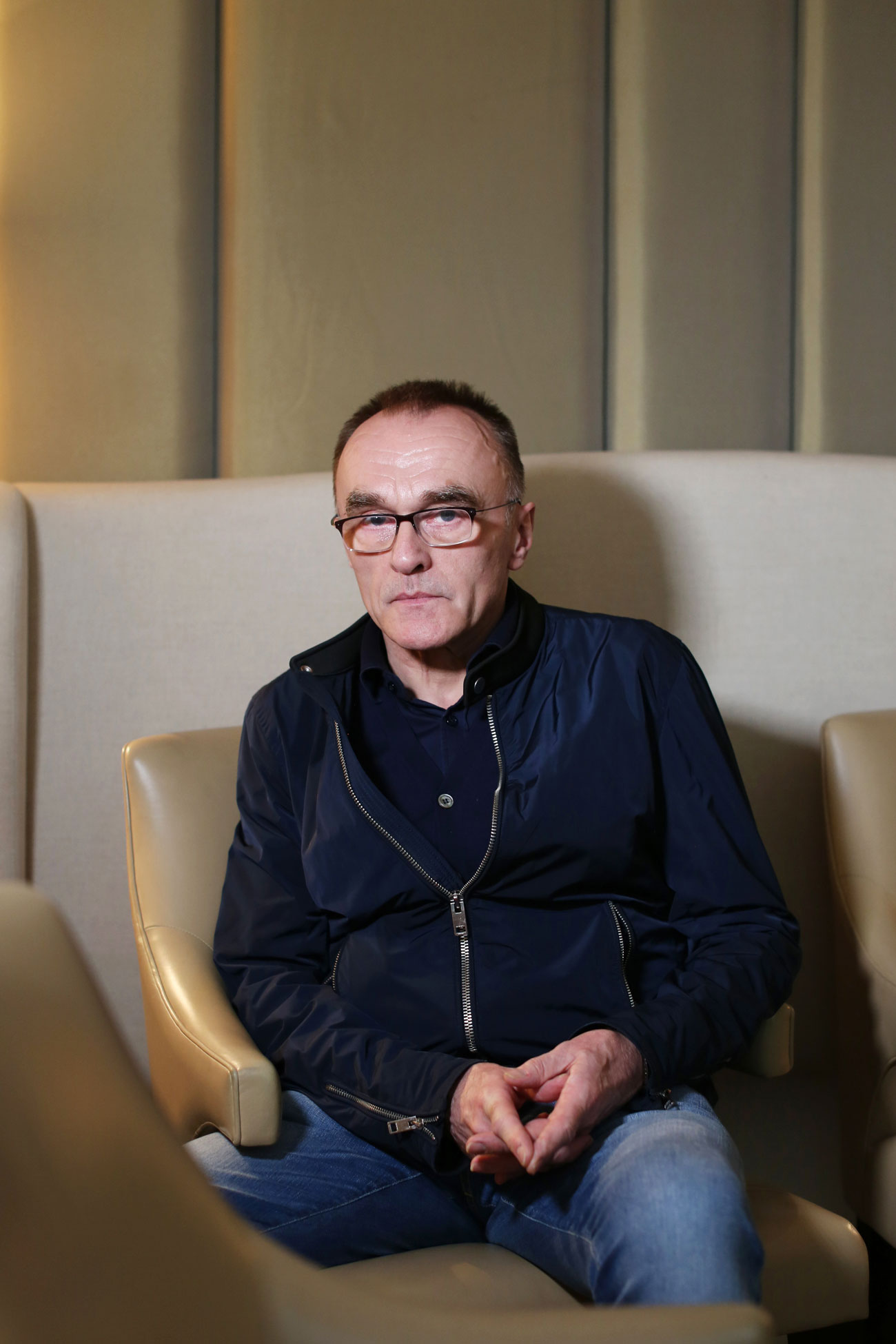
Danny Boyle. Portrait by Imogen Freeland
Boyle has strong views on the ethics of filmmaking. "You arrive with all this money, and you spend it in the city—and so does the crew, who have per diems—so there's an economic benefit, and it's why cities often encourage you to come to them. But there should be a cultural benefit to it, too. There was another guy who lived at the top of one of the tower blocks in Greendykes, and he's still a heroin addict, so we talked to him a lot and used his place as a location because then you can give him money. You're trying to pay it forward rather than nipping in and nipping out. That's always the danger... filmmaking is terribly colonial." Boyle grabs me tightly by the shoulders and shakes me to illustrate his point. "We'll grab you, take what we want from you, and then fuck off and you'll never hear from us again. So we try not to do that. Well, you are doing that, actually, but you're trying not to do it."
It took a long time to get T2 to the screen. Ten years ago John Hodge, the screenwriter of both films, tried to faithfully adapt Porno, but the unanimous feeling was that the film shouldn't be made. Plus, Boyle and McGregor famously fell out when Leonardo DiCaprio was cast as the lead in The Beach, instead of McGregor, who until that point had a special working relationship with the director. "Then John wrote something much more personal. When Renton says, 'I'm 46 and I'm fucked,' and he's got '30 more years left and what the fuck am I gonna do with that?,' that's John," says Boyle. "He started writing that through the prism of these characters, and it didn't feel like going through the numbers of Irvine's story. It feels more raw. That's why we decided to do it. We thought it was something that we could send to the guys and they'd like."

Still from 'T2: Trainspotting'
Still, the expectation from both film critics and fans that it would bastardize the legacy of the original has loomed over T2's release. Trainspotting is legendary. For teenagers, knowing the film inside out is a piece of cultural capital akin to telling people you love Catcher in the Rye, or that Melvin Burgess's Smack speaks to you on a personal level. Think of the money the government must have made from people buying the "Choose Life" posters. For kids growing up in Edinburgh, like the guys in Young Fathers, it was, as Kayus Bankole says, "a bible."
"The film is a rite of passage and was something to be proud of growing up," says Alloysious Massaquoi. "I used to hang around with older guys, and I thought, I know people like this in the film—these nutters. It felt real. On top of that, it was a hit film from where I was growing up with Scottish people in it." G Hastings adds: "It was the first time I'd ever heard someone that talked like me in a film. Irvine Welsh had a cameo, and he's from the same area that I'm from, so he spoke in a north Edinburgh accent. I can't imagine watching the film as people outside Edinburgh would watch it."
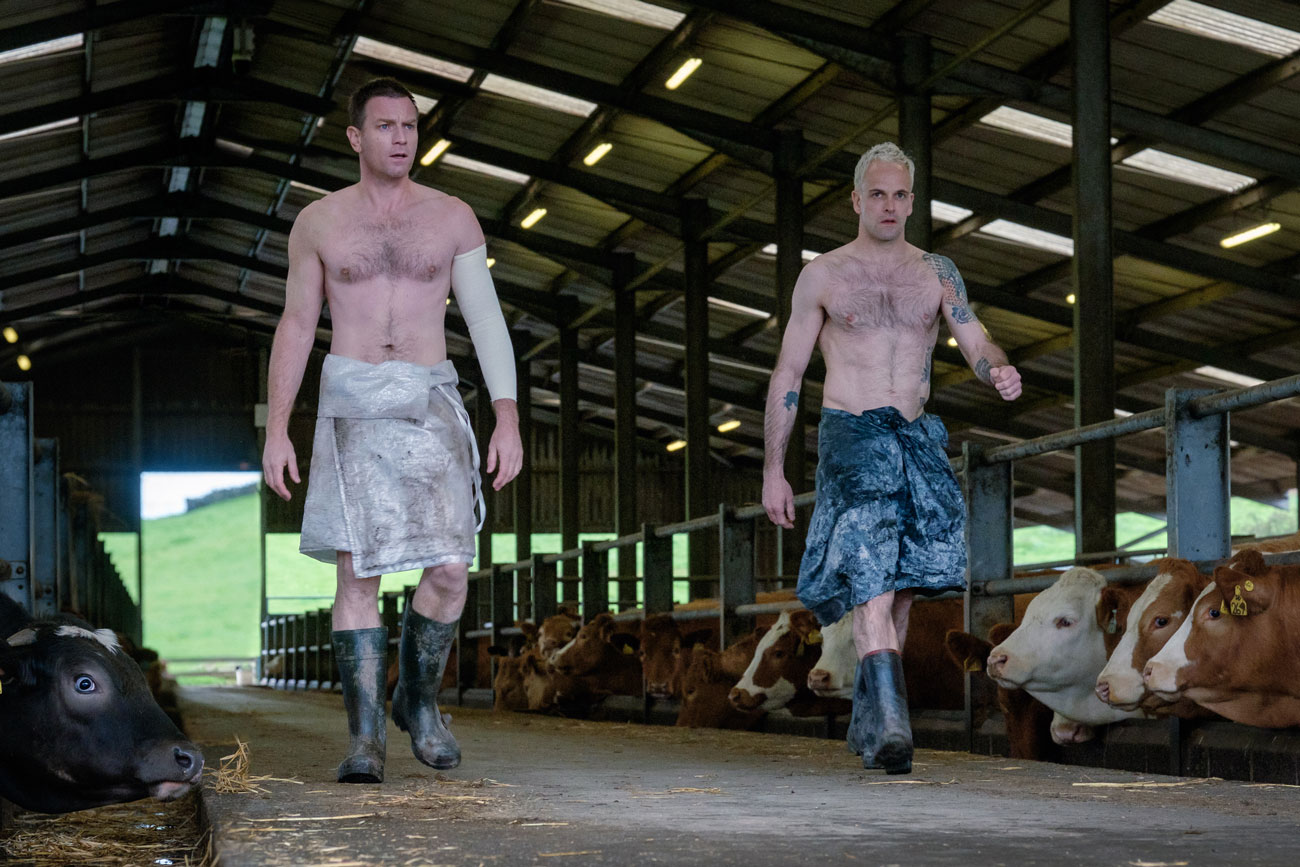
Renton and Sick Boy in a still from 'T2: Trainspotting'
One contributing factor to the original film's cult appeal was its soundtrack. By his own admission, Boyle used to be "fucking good" at picking soundtracks. Now, it's more difficult: "As you get older, someone mentions a band, and you go, 'Who are they?'"
Young Fathers' music is what he settled on for the new "heartbeat" of Edinburgh. "It was only afterwards, when we were doing the publicity, that I realized this music is born out of the same place where Irvine wrote the stories and the characters," says Boyle. "There's that connection. We used three or four of the tracks, but we could've used another half dozen. You could've done the whole film with it."
It wasn't just the music that had to be perfect—the actors had the performances of most of their careers to compete with. "They were anxious. You could tell they were. They didn't want it to be shite," admits Boyle. "It'd be so humiliating if it was terrible." As an apparent attempt to address the enormity of the original film, T2 is extremely self-referential. There are flashbacks, much is made of Spud's storytelling of the Trainspotting years, and Renton even attempts an updated Choose Life speech for 2017.
"The first film was almost an artifact, and the characters know the first film exists," Boyle says. "There's actually only one minute of Trainspotting in this film. It seems like a lot more, but it isn't. We used that as a resource to draw on, and the actors knew it would make them look bad. Who looks better in their mid 40s than they did in their mid 20s? They knew it would be tough like that. But it connects them back with us because movie actors often feel like they're different from us, yet they're aging like we all do. It's the common fate of all of us."

Spud in a still from 'T2: Trainspotting'
What T2 does do well is depict a group of men making a very weak attempt to leave the past behind. Renton's come back to Edinburgh, despite fucking off forever to Amsterdam, and it's all of 15 minutes before the characters are up to their old tricks. The pull of place is enduring; if only they could get out of Edinburgh, maybe they'd be able to cut ties with all those toxic people and toxic substances, and change their own poisonous behavior.
"I come from Manchester, and it's the same thing—you think, I'll leave and I'll make progress, but you'll end up there," says Boyle. "They say that 93 percent of British people die within seven miles of where they were born. You end up going back where you started."
In Trainspotting, we saw Renton swigging vodka, telling us: "It's shite being Scottish. We're the lowest of the low. The scum of the fucking earth!" But Renton will never have the strength to leave Edinburgh—and neither will any of the others.
T2 Trainspotting is out in theaters March 17.
Follow Hannah Ewens on Twitter.
Sipping on Gin and Juice with Snoop Dogg
Few artists enjoy the staying power of Snoop Dogg. Nearly 25 years since the debut of his breakthrough album Doggystyle, the singer, television star, and medical cannabis entrepreneur is as culturally relevant as ever. Part of that has to do with his prolific nature (he released 127 singles during those two and a half decades) but Snoop's infectious affability surely plays a role in his continued success, too. After all, kindness never goes out of style.
Nor does marijuana, incidentally. Snoop's all-but-official status as the global ambassador of ganja has also helped cement his legacy. MUNCHIES sat down with Snoop in downtown LA over a few gin and juice cocktails, where he revealed everything from his secret stoner snacks to the one person who can smoke him under the table. Most importantly, though, this brief session with the hip-hop icon provides a few life lessons in longevity.
MUNCHIES: What are we drinking?
Snoop Dogg: [It's The Laid Back Cocktail prepared by Niko Novick of N2 Mixology, with one part gin, one part apple vodka, two parts fresh pineapple juice, and a splash of soda, on the rocks.]
You know, Martha Stewart made this same drink for me on my show [ Martha and Snoop's Potluck Dinner Party]. But she put a ball [of ice] in it, though. A big-ass ball. That motherfucker—I ain't never drunk a drink with a big-ass ball. It fucked me up, but it was good. I never thought I'd say I liked balls, but…You gotta add that gingeriz-nale, a little pine-a-pale, and you gotta chop chop [that ice].
Your friendship with Martha is unexpected yet genuine. How do you two work so well together?
She different, ya know, than what I'm accustomed up. But then again she's so what I'm accustomed to, 'cause she people. She just look different and she was born in a different era, but if you hang out with her and chill with her, she just like anybody else. That's why it works, because she never says nothing that's crazy in my ears. It's always like, damn, I thought you would say that, OK. That's why we get down, that's why we connected, Martha. 'Cause it feels like holy matrimony, and not holy macaroni.
Read more on MUNCHIES
Sylvester Stallone's Instagram Is the Only True Art Left in This Cold, Ugly World
There is an important montage in Rocky IV that tells you all you need to know about the Rocky movies, namely: They are not about boxing. I mean, yes: Rocky is a boxer, and literally every Rocky film ends in a boxing match, which Rocky either wins ( II, III, IV) or valiantly just barely loses ( I, Balboa), and he is then presented with a microphone, his face just a large pink piece of meat now, with red and Vaseline on it, and sweat all down him, and someone decides now is the best time to talk to him, and so he sort of gags something into the mic—"If I can change, and you can change, everybody can change!" or something like that, sounding a lot like you do after you've just thrown up at a party, and you're desperately asking your mate to fetch you some water—and the crowd all cheer, and his wife sniffs once and cries. This is every Rocky film. So you would be forgiven for thinking the Rocky films are about boxing. They're not.
So I could go on some sort of saccharine naval gazing bit about how Rocky films are about heart, and family, and overcoming adversary, and that hard work can trump natural athleticism, and that getting punched really hard and repeatedly in the head is superbly heroic, or the importance of running up steps, but as the Rocky montage from Rocky IV tells you: No, the Rocky films are about one thing, and one thing only. They're about being insane and strong in a field is a better training technique than actually working out in a gym, always.
Consider: Rocky I, he fought to a draw by punching meat in factories, being raced by children and chasing a chicken around a yard. Rocky II: OK, he worked out in a gym, and he won. Discount that. Rocky III: Rocky got cocky, got beaten by a much younger and fiercer fighter, and to regain his old form had to go do homoerotic shuttle sprints on a beach with Apollo Creed and go swimming for a bit. Rocky IV: just fucking run through snow a lot. Balboa: be really old and strong in a dimly lit gym, extended saxophone solo soundtrack.
So the lesson to be learned from the Rocky films is this: Not everything, on the surface, is exactly what it seems. Not everything is about what you think it is about. Sometimes you have to peel back a flap of skin to see the true, red, raw beating heart within: What's on the surface won't tell you everything you need to know about something. Let's take an example: You might think Sylvester Stallone's Instagram account is just an Instagram account. But you are wrong. It is actually art.
I think to truly appreciate Sylvester Stallone's Instagram account for what it is we have to consider it from the point of view of what it isn't. Namely: This is not an Instagram account in any sense of the word. Go look at your Instagram, now: a carefully curated color palette of warm homeware shots, pictures of single cocktails you ordered at bars, a plate of brunch, a photo where you look cute. This is Instagram: a self-curated feed of what you eat, drink, look like, and where you live. How many dogs you have met this week. A sign you saw, once, or some graffiti. Decent sunsets. That's it. There is that overriding idea—spawned from a Thought Catalog piece about two years ago, if we want to apportion blame—an idea that social media is "just the highlights reel," a focus on the good and a careful sidestepping of the bad, and no more is that so than on Instagram: We never cry on Instagram; we are rarely melancholy. We are never hungry, and we have never eaten "just toast" for dinner. Our hair is always perfectly coiffed and never wet from the rain. Say you sit in a small pool of cum in the back of a taxi—and we've all done it!—that will not make it to Instagram. Instagram is about the light, not the shade. Is it the best of us all with no flaws.
So Sylvester Stallone's Instagram feed is not like that. Because Sylvester Stallone's Instagram feed, roughly:
— Short videos where Sylvester Stallone is harassing his brother, Frank*, who looks like what Elvis's inevitable endgame would have been had he lived long enough to get to that point. You Either Die as Elvis or Live Long Enough to See Yourself Become Frank Stallone;
— Short videos where Sylvester Stallone tells impenetrable dad jokes to his model daughters, who are tired of this but trying not to show it;
— 30-year-old behind-the-scenes Rocky stills, because as discussed the Rocky films are the greatest &c. &c. &c.;
And I find this consistency soothing, like a pill. I feel this is important. So let's take a look through a few of Sylvester Stallone's greatest Instagram hits, and then all at the end agree that I am right and that this is the most perfect art currently available in the world, amen.
Art #1: "Sylvester Locks the Door"
So, I mean, at first you are watching this and thinking, This is not art. This is two ancient, strong, smooth-faced men quarreling with half-banter like 12-year-olds. This is not art at all. Wrong! Watch the video again, for it is a mess: Frank's talking over Sly; Sly's saying shit like, "Hey Frank, can you swim? Why–why don't you do a backflip, into that puddle?" Like, I mean, these jokes are awful, and also Frank is dressed like some insane dude they just pulled out of a jungle to tell him the Vietnam War ended 42 years ago and can you please stop fighting now. And then it comes to a close: perfect-focused rain drops on glass; Frank, gauzy in the background, immaculate golf swing; and then the words, "the idiot." I'm pretty sure that's the end of every French arthouse film ever made.
Art #2: "A Portrait of a Man at Peace"
Think about Sylvester Stallone in the quiet moments of his life. Sylvester Stallone, old and strong and with a hairline like iron, just puttering about his palatial LA home. He eases onto a sofa and makes a creaking sound. He puts on a small pair of glasses to look at an iPad. Maybe Sylvester Stallone makes a pasta sauce, carefully chopping an onion with his gigantic hands. When do you think Sylvester Stallone last cried in the shower? I bet it's been decades. When do you think he last got mad about a parking fine? There's no need to. I like to think of him as a man of peace, as he is here: so calm he has forgotten a word, so zen he can zig-zag through traffic while simultaneously delivering an Instagram sizzler about Expendables 4. And this one's really fun because he has to do a whole move at the end to turn the recording bit off and looks for a second like a strong but ancient Honey Bun Baby:

So that's art.
Art #3: "Sylvester Stallone Is the Strongest Dad in the World"
When I was a kid, at primary school, we always used to settle fights like this: We would brag about how hard our dads were. You know how it goes: Someone throws your cheese sandwich on the floor, or stomps on your Babybel, or calls you a poo-head or something, and you lock them square in the eyes and say: "My dad could beat your dad up." Or: "Oh yeah? Well my dad's harder than your dad." I mean, I never actually did this because, even at seven, I sort of suspected my dad was a pussy and would last a flimsy four to seven seconds in any sort of violent situation with anyone else's dad. "Car Park Pagga Called Off," the headlines would say, "After Joel's Dad Got So Scared He Pissed His Jeans." Or: "Tony Golby's Thick Nerd Glasses Split Perfectly in Two By Single Dad-Punch, Also He Is Still Unconscious Somehow." That sort of thing.
The hardest dad in the world, though—the dad who could beat all other dads—is Sylvester Stallone. But it is important that you know he is still a dad. This is why he reminds us by filming these videos with his gazelle-like daughters. I don't know how many daughters he has, because they are all identical, but I think it's somewhere between three and 40, and they all get a sort of fleeting look of panic in their eyes when he turns the front-facing camera around on them—the subtext, I think, of Sylvester Stallone's Instagram, is that he videos a good eight, ten hours of his day, but the ones we see are just the ones he deigns to put online—an "ah, no, not this shit again" eye-roll. And this is a perfect example of that: a simple, pure, family moment (daughter dancing foolishly) hijacked by 20 consistent seconds of daddery ("No, come on… you're going to pull something") for absolutely no reason at all, then topped with the cherry of a joke that makes absolutely no sense at all and isn't by any traditional metrics a joke, but is delivered like a joke so I guess it is a joke?, and that joke is: "Yeah. DANCING WITH THE BARS."
Sometimes art doesn't have to make sense.
Art #4: Strength
At one point you just get so strong you can only do this pose in photos, as per the written rules of the law, and just look how flawless this is. Look. It's like Sylvester Stallone is so strong his own spine is struggling to contain the strength of him. How many thousands, hundreds of thousands, of photos are there of Sylvester Stallone doing a single fist to the camera? Scientists cannot calculate that number. Art.
Art #5: "This Is How You Kill Frank Stallone"
Have you ever thought what it might be like to murder Frank Stallone? No, me… me neither. What about murdering Frank Stallone while uttering a semi-weak Elton John joke, sort of like in 80s cop-buddy movies where you have to say something smart after you shoot or arrest someone? No, I… I have never done that, either. But if you ever wanted to envision what that would be like, then it would be like this. This is what strangling Frank Stallone looks like. It would be art.
I just like it, you know? Every celebrity—and, indeed, every person alive; you don't necessarily need to be famous to only post the good selfies on Instagram—curates, retouches, polishes their online presence, runs it through a team, tweets their initials on the rare times they actually say what's been attributed to them, lives a distant life, far removed from the rest of us. But not Sylvester Stallone. Sylvester Stallone is really fucking about on Instagram. He basically just spends his time mildly irritating the people closest to him and then does a big fist about it at the camera.
We all need a bit of an escape, sometimes, don't we, in this cold, cold world, and that's where art comes in. Art can be expensive, and it can be challenging; it can be obtuse, and it can be provocative. It can be difficult to decipher. But it could just be Sylvester Stallone looking sad about Drake in the back of a taxi. Hard to know.
Follow Joel Golby on Twitter.
* Frank Stallone, side-note, is a keen collector of Trump merchandise so niche I can't even believe it exists. Does he own a red MAGA cap? He does not. He owns a camo-print MAGA hat, because that is more American. On the day of the election, Frank Stallone donned an eerie rubber full-head Trump mask (a thing?) then made a video of himself, as Trump, thanking himself, Frank Stallone, for his vote. He put a tiny cardboard MAGA hat decorative on his Christmas tree. He owns a boxed vinyl toy of Hillary Clinton in prison, which… I mean, I don't even know where you would even go about buying that thing. Anyway, yes: my 9,000-word article, "A Deep Dive Into Frank Stallone's Trump Merch Collection, and the Lessons We Can Learn Within" is due to come out next week.
Trump Signs 'Extreme Vetting' Order to Block Refugees
On Friday, President Donald Trump pledged to "keep radical Islamic terrorists out of the United States of America" by signing an executive order aimed at creating stricter vetting for immigrants from countries plagued by terrorism.
According to Yahoo News, Trump signed the document at a swearing-in ceremony for Secretary of Defense James Mattis at the Pentagon.
Trump's order calls for a temporary ban on all refugees seeking entry to the United States for 120 days, as well as a 90-day visa ban for visitors and immigrants from Iran, Iraq, Libya, Somalia, Sudan, Syria, and Yemen and other "areas of concern." Refugees from Syria will be barred until "significant changes" that are "consistent with the national interest" are made.
Furthermore, Trump's order gives precedent to Christian Syrians who apply for refugee status in a provision that gives preferential treatment to minority groups seeking asylum "on the basis of religious-based persecution."
Though not mentioning Islam by name, the order seeks to keep out "those who would place violent ideologies over American law."
"In addition," it continues, "the United States should not admit those who engage in acts of bigotry or hatred (including "honor" killings, other forms of violence against women, or the persecution of those who practice religions different from their own) or those who would oppress Americans of any race, gender, or sexual orientation."
The order also suspends the Visa Interview Waiver Program, a service that permits certain legal immigrants from renewing their documents without a face-to-face interview.
"We are establishing new vetting measures, to keep radical Islamic terrorists out of the United States of America," Trump said Friday. "We don't want 'em here. We want to ensure we aren't admitting into our country the very threats that our men and women are fighting overseas."
Many organizations, including the ACLU, denounced the order as Islamophobic.
UPDATE 8:36 PM EST: This post has been updated with newly released text from the executive order.
We're tracking the laws and executive orders Trump signs in his first year in office. The updated list is here.
Za ile wielbłądów moglibyśmy sprzedać polski rząd?
Jeśli kiedykolwiek pojedziesz na wakacje na Bliski Wschód, na pewno usłyszysz swoją wartość w wielbłądach – to nieodzowne jak podrobione torebki Prady w Turcji albo schlane gimby w Złotych Piaskach. Każde takie zdarzenie jest później szeroko komentowane w knajpach i przy rodzinnych stołach. Czy traktować je jako poważną propozycję? Komplement? Wyraz zacofania arabskiej kultury?
Cóż, według według jednej z wykładowczyń z katedry Arabistyki i Islamistyki Uniwersytetu Warszawskiego (która o temacie nie chciała wypowiadać się pod nazwiskiem), takie oferty to tylko beka z Europejczyków, którzy „pojęcie o kulturze arabsko-muzułmańskiej często sprowadzają do haremów". „W początkach kultury beduińskiej, gdzie przed erą pieniądza handel barterowy przy pomocy wielbłądów faktycznie miał miejsce" – tłumaczy. „Obecnie nic takiego się nie dzieje, a wspomniane propozycje wyśmiewają się ze stereotypu".
Znaleźliśmy jednak stronę, która za pomocą paru czynników – wzrost, wiek, kolor włosów i wielkość biustu – ocenia, ile dana osoba byłaby w wielbłądach warta. I chociaż autor Camel Calculatora wyznał nam, że niestety nie opiera swojego algorytmu na żadnych antropologicznych obserwacjach tylko prostym matematycznym działaniu, i tak sprawdziliśmy, za ile można by opchnąć polskich polityków.
Beata Szydło, Prezes Rady Ministrów - 29 wielbłądów

Piotr Gliński, Minister kultury i dziedzictwa narodowego - 33 wielbłądy

Jarosław Gowin, Minister nauki i szkolnictwa wyższego - 55 wielbłądów

Mateusz Morawiecki, Minister rozwoju i finansów - 48 wielbłądów

Andrzej Adamczyk, Minister infrastruktury i budownictwa - 51 wielbłądów

Witold Bańka, Minister sportu i turystyki - 59 wielbłądów

Mariusz Błaszczak, Minister spraw wewnętrznych i administracji - 62 wielbłądy (najwyższy wynik)

Marek Gróbarczyk, Minister gospodarki morskiej i żeglugi śródlądowej - 54 wielbłądy

Krzysztof Jurgiel, Minister rolnictwa i rozwoju wsi - 31 wielbłądów

Mariusz Kamiński, Koordynator służb specjalnych - 47 wielbłądów

Beata Kempa, Szefowa Kancelarii Prezesa Rady Ministrów - 29 wielbłądów

Henryk Kowalczyk, Przewodniczący Komitetu Stałego Rady Ministrów - 35 wielbłądów

Antoni Macierewicz, Minister obrony narodowej - 38 wielbłądów

Konstanty Radziwiłł, Minister zdrowia - 50 wielbłądów

Elżbieta Rafalska, Minister rodziny, pracy i polityki społecznej - 26 wielbłądów

Anna Streżyńska, Minister cyfryzacji - 44 wielbłądy

Jan Szyszko, Minister środowiska - 28 wielbłądów

Krzysztof Tchórzewski, Minister energii - 35 wielbłądów

Witold Waszczykowski, Minister spraw zagranicznych - 50 wielbłądów

Elżbieta Witek, członkini Rady Ministrów - 22 wielbłądy (najniższy wynik)

Anna Zalewska, Minister edukacji narodowej - 28 wielbłądów

Zbigniew Ziobro, Minister sprawiedliwości, prokurator generalny - 56 wielbłądów

Cały rząd osiąga wysoki wynik 910 wielbłądów. Zważywszy, że za jednego typowego dwugarba można dostać nawet trzynaście tysięcy funtów, sprzedanie wszystkich po takim kursie starczyłoby na 120 401 wypłat 500+ albo załatałoby 0,006% obecnego długu publicznego. Ewentualnie można by za to wyjechać na zajebiste wakacje w Egipcie.
BONUS
Ryszard Petru, przewodniczący Nowoczesnej - 57 wielbłądów

Grzegorz Schetyna, przewodniczący Platformy Obywatelskiej - 53 wielbłądy

Jarosław Kaczyński, przewodniczący Prawa i Sprawiedliwości - 28 wielbłądów

Dla porównania, dziewczyna Janka, redaktora tłumaczeń VICE Polska, została kiedyś wyceniona na 70 wielbłądów, co chyba nie świadczy najlepiej o naszej władzy.